Motorola Solutions 89FT7622 5.7GHz Fixed Wireless (ISM) User Manual CanopyR8UserGuideIss2RegDraft
Motorola Solutions, Inc. 5.7GHz Fixed Wireless (ISM) CanopyR8UserGuideIss2RegDraft
Contents
- 1. Exhibit D Users Manual Part 1 per 2 1033 b3
- 2. Exhibit D Users Manual Part 2 per 2 1033 b3
- 3. Exhibit D Users Manual Part 3 per 2 1033 b3
- 4. Exhibit D Users Manual Part 4 per 2 1033 b3
- 5. Exhibit D Users Manual Part 5 per 2 1033 b3
- 6. Exhibit D Users Manual Part 6 per 2 1033 b3
- 7. Exhibit D Users Manual Part 7 per 2 1033 b3
- 8. Exhibit D Users Manual Part 8 per 2 1033 b3
- 9. Exhibit D Users Manual Part 9 per 2 1033 b3
- 10. Users Manual
Exhibit D Users Manual Part 2 per 2 1033 b3

Release 8 Installation and Configuration Guide
Issue 2, December 2006 Draft 2 for Regulatory Review 167
I
INSTALLATION
NSTALLATION
A
AND
ND
C
CONFIGURATION
ONFIGURATION
G
GUIDE
UIDE

Release 8 Installation and Configuration Guide
Issue 2, December 2006 Draft 2 for Regulatory Review 169
15 AVOIDING HAZARDS
Use simple precautions to protect staff and equipment. Hazards include exposure to RF
waves, lightning strikes, and power surges. This section specifically recommends actions
to abate these hazards.
15.1 PREVENTING OVEREXPOSURE TO RF ENERGY
To protect from overexposure to RF energy, install Canopy radios so as to provide and
maintain the minimum separation distances from all persons shown in Table 40.
Table 40: Exposure separation distances
Canopy module
Minimum separation distance from all persons
Antenna of 900-MHz AP or SM
60 cm
24 in
2.4-, 5.2-, 5.4-, or 5.7-GHz radio
with no reflector
20 cm
8 in
2.4-, 5.4-, or 5.7-GHz radio
with a reflector
1.5 m
60 in (5 ft)
Antenna of connectorized 5.7 GHz AP
20 cm
8 in
At these and greater separation distances, the power density from the RF field is below
generally accepted limits for the general population.
−
NOTE:
These are conservative distances that include compliance margins. In the case
of the reflector, the distance is even more conservative because the equation
used models the reflector as a point source and ignores its physical dimensions.
15.1.1 Details of Calculations for Separation Distances and Power Compliance
Margins
Limits and guidelines for RF exposure come from:
◦ US FCC limits for the general population. See the FCC web site at
http://www.fcc.gov, and the policies, guidelines, and requirements in Part 1 of
Title 47 of the Code of Federal Regulations, as well as the guidelines and
suggestions for evaluating compliance in FCC OET Bulletin 65.
◦ Health Canada limits for the general population. See the Health Canada web site
at http://www.hc-sc.gc.ca/rpb and Safety Code 6.
◦ ICNIRP (International Commission on Non-Ionizing Radiation Protection)
guidelines for the general public. See the ICNIRP web site at
http://www.icnirp.de/ and Guidelines for Limiting Exposure to Time-Varying
Electric, Magnetic, and Electromagnetic Fields.

Installation and Configuration Guide Release 8
170 Draft 2 for Regulatory Review Issue 2, December 2006
The applicable power density exposure limits from the documents referenced above are
◦ 6 W/m2 for RF energy in the 900-MHz frequency band in the US and Canada.
◦ 10 W/m2 for RF energy in the 2.4-, 5.2-, 5.4-, and 5.7-GHz frequency bands.
Peak power density in the far field of a radio frequency point source is calculated as
follows:
where
S = power density in W/m2
P = RMS transmit power capability of the radio, in W
G = total Tx gain as a factor, converted from dB
d = distance from point source, in m
Rearranging terms to solve for distance yields
P
G
.
4 p
d
S
=
Calculated Distances and Power Compliance Margins
Table 41 shows calculated minimum separation distances d, recommended distances
and resulting power compliance margins for each frequency band and antenna
combination.
Table 41: Calculated distances and power compliance margins
Variable
Frequency
Band
Antenna
P
G
S
d
(Calcu-
lated)
Recom-
mended
Distance
Power
Compliance
Margin
900 MHz
external
0.4 W
(26 dBm)
10.0
(10 dB)
6 W/m2
0.23 m
60 cm
(24 in)
7
internal
0.34 W
(25 dBm)
6.3
(8 dB)
10 W/m2
0.13 m
20 cm
(8 in)
2.3
2.4 GHz
internal
plus
reflector
0.34 W
(25 dBm)
79.4
(19 dB)
10 W/m2
0.46 m
1.5 m
(5 ft)
10
internal
0.2 W
(23 dBm)
5.0
(7 dB)
10 W/m2
0.09 m
20 cm
(8 in)
5
5.2 GHz
internal
plus
reflector
0.0032 W
(5 dBm)
316
(25 dB)
10 W/m2
0.09 m
1.5 m
(5 ft)
280
internal
0.2 W
(23 dBm)
5.0
(7 dB)
10 W/m2
0.09 m
20 cm
(8 in)
5
5.4 GHz
internal
plus
reflector
0.0032 W
(5 dBm)
316
(25 dB)
10 W/m2
0.09 m
1.5 m
(5 ft)
280
S =
P •
G
4 π d
2
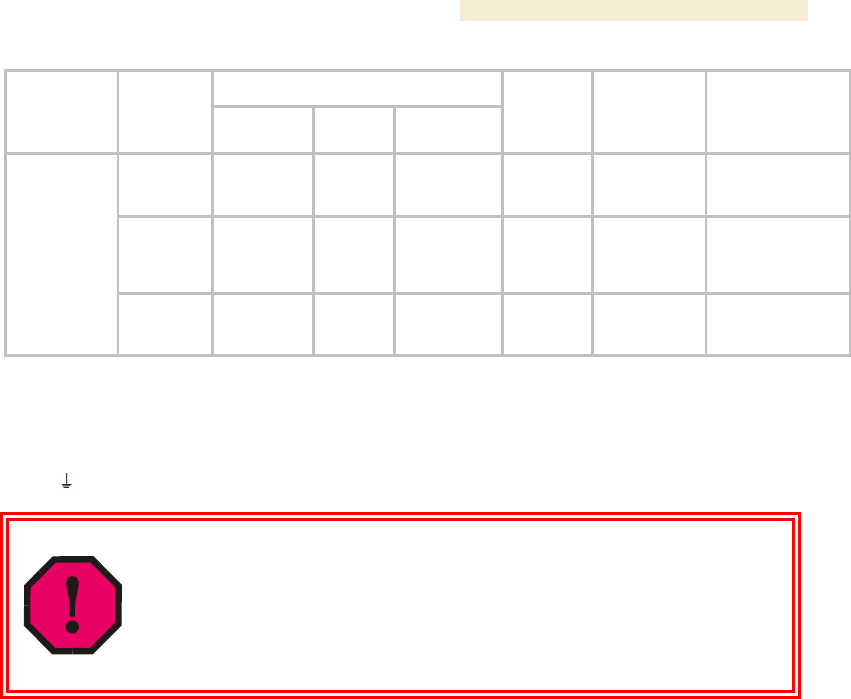
Release 8 Installation and Configuration Guide
Issue 2, December 2006 Draft 2 for Regulatory Review 171
Variable
Frequency
Band
Antenna
P
G
S
d
(Calcu-
lated)
Recom-
mended
Distance
Power
Compliance
Margin
internal
0.2 W
(23 dBm)
5.0
(7 dB)
10 W/m2
0.09 m
20 cm
(8 in)
5
internal
plus
reflector
0.2 W
(23 dBm)
316
(25 dB)
10 W/m2
0.71 m
1.5 m
(5 ft)
4.5
5.7 GHz
external
0.125 W
(21 dBm)
31.6
(15 dB)
10 W/m2
0.18 m
20 cm
(8 in)
1.27
15.2 GROUNDING CANOPY EQUIPMENT
Effective lightning protection diverts lightning current safely to ground, Protective Earth
(PE)
. It neither attracts nor prevents lightning strikes.
WARNING!
Lightning damage is not covered under the Canopy warranty. The
recommendations in Canopy guides give the installer the knowledge to protect
the installation from the harmful effects of ESD and lightning. These
recommendation must be thoroughly and correctly performed. However,
complete protection is neither implied or possible.
15.2.1 Grounding Infrastructure Equipment
To protect both your staff and your infrastructure equipment, implement lightning
protection as follows:
◦ Observe all local and national codes that apply to grounding for lightning
protection.
◦ Before you install your Canopy modules, perform the following steps:
− Engage a grounding professional if you need to do so.
− Install lightning arrestors to transport lightning strikes away from equipment.
For example, install a lightning rod on a tower leg other than the leg to which
you mount your module.
− Connect your lightning rod to ground.
− Use a Canopy 300SS Surge Suppressor (or Transtector ALPU-ORTs for
OFDM BH installations) on the Ethernet cable where the cable enters any
structure. (Instructions for installing a Canopy 300SS Surge Suppressor are
provided in Procedure 28 on Page 346.)
◦ Install your modules at least 2 feet (0.6 meters) below the tallest point on the
tower, pole, or roof.

Installation and Configuration Guide Release 8
172 Draft 2 for Regulatory Review Issue 2, December 2006
15.2.2 Grounding Canopy 30/60- and 150/300-Mbps Backhaul Modules
For grounding the Canopy OFDM series backhaul modules, see the details, caveats, and
wiring schemes provided in the following documents:
◦ Canopy 30 Mbps 60 Mbps Backhaul User Guide
◦ Lightning Arrestor Alert Notice
◦ Canopy 30/60 & 150/300 Mbps OFDM Backhaul Lightning Arrestor Guide.
15.2.3 Grounding SMs
This section provides lightning protection guidelines for SMs to satisfy the National
Electrical Code (NEC) of the United States. The requirements of the NEC focus on the
safety aspects of electrical shock to personnel and on minimizing the risk of fire at a
dwelling. The NEC does not address the survivability of electronic products that are
exposed to lightning surges.
The statistical incidence of current levels from lightning strikes is summarized in
Table 42.
Table 42: Statistical incidence of current from lightning strikes
Percentage
of all strikes
Peak Current
(amps)
<2
>140,000
25
>35,000
>50
>20,000
>80
>8,500
At peak, more than one-half of all surges due to direct lightning strikes exceed 20,000
amps. However, only one-quarter exceed 35,000 amps, and less than two percent
exceed 140,000 amps. Thus, the recommended Surge Suppressor (300SS) provides
a degree of lightning protection to electronic devices inside a dwelling.
Summary of Grounding Recommendations
Motorola recommends that you ground each SM as follows:
◦ Extend the SM mounting bracket extend to the top of the SM or higher.
◦ Ground the SM mounting bracket via a 10-AWG (6 mm2) copper wire connected
by the most direct path either to an eight foot-deep ground rod or to the ground
bonding point of the AC power service utility entry. This provides the best
assurance that
− lightning takes the ground wire route
− the ground wire does not fuse open
− your grounding system complies with NEC 810-15.
◦ Ground the Canopy Surge Suppressor 300SS ground lug to the same ground
bonding point as above, using at least a 10-AWG (6 mm2) copper wire. This
provides the best assurance that your grounding system complies with
NEC 810-21.

Release 8 Installation and Configuration Guide
Issue 2, December 2006 Draft 2 for Regulatory Review 173
Grounding Scheme
The proper overall antenna grounding scheme per the NEC is illustrated in Figure 134 on
Page 347. In most television antenna or dish installations, a coaxial cable connects the
outdoor electronics with the indoor electronics. To meet NEC 810-20, one typically uses
a coaxial cable feed-through block that connects the outdoor coax to the indoor coax and
also has a screw for attaching a ground wire. This effectively grounds the outer shield of
the coax. The block should be mounted on the outside of the building near the AC main
panel such that the ground wire of the block can be bonded to the primary grounding
electrode system of the structure.
For residential installs, in most cases an outdoor rated unshielded twisted pair (UTP)
cable is sufficient. To comply with the NEC, Motorola provides the antenna discharge
unit, 300SS, for each conductor of the cable. This 300SS must be
◦ positioned
− outside the building.
− as near as practicable to the power service entry panel of the building and
attached to the AC main power ground electrode, or attached to a grounded
water pipe.6
− far from combustible material.
◦ grounded in accordance with NEC 810-21, with the grounding wire attached to
the screw terminal.
The metal structural elements of the antenna mast also require a separate grounding
conductor. Section 810-15 of the NEC states:
Masts and metal structures supporting antennas shall be grounded in
accordance with Section 810-21.
As shown in Figure 134 on Page 347, the Motorola recommendation for grounding the
metal structural element of the Canopy mounting bracket (SMMB1) is to route the
grounding wire from the SMMB1 down to the same ground attachment point as is used
for the 300SS discharge unit.
Use 10-AWG (6 mm2) Copper Grounding Wire
According to NEC 810-21 3(h), either a 16-AWG copper clad steel wire or a 10-AWG
copper wire may be used. This specification appears to be based on mechanical strength
considerations and not on lightning current handling capabilities.
For example, analysis shows that the two wire types are not equivalent when carrying
a lightning surge that has a 1-microsecond rise by 65-microsecond fall:
◦ The 16-AWG copper clad steel wire has a peak fusing current of 35,000 amps
and can carry 21,000 amps peak, at a temperature just below the ignition point
for paper (454° F or 234° C).
◦ The 10-AWG copper wire has a peak fusing current of 220,000 amps and can
carry 133,000 amps peak, at the same temperature.
6 It is insufficient to merely use the green wire ground in a duplex electrical outlet box for grounding
of the antenna discharge unit.

Installation and Configuration Guide Release 8
174 Draft 2 for Regulatory Review Issue 2, December 2006
Based on the electrical/thermal analysis of these wires, Motorola recommends 10-AWG
copper wire for all grounding conductors. Although roughly double the cost of 16-AWG
copper clad steel wire, 10-AWG copper wire handles six times the surge current from
lightning.
Shielding is not Grounding
In part, NEC 810-21 states:
A lightning arrester is not required if the lead-in conductors are enclosed in a
continuous metal shield, such as rigid or intermediate metal conduit, electrical
metallic tubing, or any metal raceway or metal-shielded cable that is effectively
grounded. A lightning discharge will take the path of lower impedance and jump
from the lead-in conductors to the metal raceway or shield rather than take the
path through the antenna coil of the receiver.
However, Motorola does not recommend relying on shielded twisted pair cable for
lightning protection for the following reasons:
◦ Braid-shielded 10Base-T cable is uncommon, if existent, and may be unsuitable
anyway.
◦ At a cost of about two-thirds more than 10-AWG copper UTP, CAT 5
100Base-TX foil-shielded twisted pair (FTP) cable provides a 24-AWG drain wire.
If this wire melts open during a lightning surge, then the current may follow the
twisted pair into the building.
More than 80 percent of all direct lightning strikes have current that exceeds
8,500 amps (see Table 42 on Page 172). A 24-AWG copper wire melts open at
8,500 amps from a surge that has a 1-microsecond by 70-microsecond
waveform. Hence, reliance on 24-AWG drain wire to comply with the intent of
NEC 810-21 is questionable.
Shielded twisted pair cable may be useful for mitigation of interference in some
circumstances, but installing surge suppressors and implementing the ground
recommendations constitute the most effective mitigation against lightning damage.
NEC Reference
NEC Article 810, Radio and Television Equipment, and associated documents and
discussions are available from http://www.neccode.com/index.php?id=homegeneral,
http://www.constructionbook.com/xq/ASP/national-electrical-code-2005/id.370/subID.746/qx/default2.htm,
and other sources.
15.3 CONFORMING TO REGULATIONS
For all electrical purposes, ensure that your network conforms to applicable country and
local codes, such as the NEC (National Electrical Code) in the U.S.A. If you are uncertain
of code requirements, engage the services of a licensed electrician.
15.4 PROTECTING CABLES AND CONNECTIONS
Cables that move in the wind can be damaged, impart vibrations to the connected device,
or both. At installation time, prevent these problems by securing all cables with cable ties,
cleats, or PVC tape.

Release 8 Installation and Configuration Guide
Issue 2, December 2006 Draft 2 for Regulatory Review 175
Over time, moisture can cause a cable connector to fail. You can prevent this problem by
◦ using cables that are filled with a dielectric gel or grease.
◦ including a drip loop where the cable approach to the module (typically a CMM2
or CMMmicro) is from above.
◦ wrapping the cable with weather-resistant tape.
On a module with an external antenna, use accepted industry practices to wrap the
connector to prevent water ingress. Although the male and female N-type connectors
form a gas-tight seal with each other, the point where the cable enters each connector
can allow water ingress and eventual corrosion. Wrapping and sealing is critical to long-
term reliability of the connection.
Possible sources of material to seal that point include
◦ the antenna manufacturer (material may have been provided in the package with
the antenna).
◦ Universal Electronics (whose web site is http://www.coaxseal.com), who markets
a weather-tight wrap named Coax-Seal.
Perform the following steps to wrap the cable.
Procedure 4: Wrapping the cable
1. Start the wrap on the cable 0.5 to 2 inches (about 1.5 to 5 cm) from the
connection.
2. Wrap the cable to a point 0.5 to 2 inches (about 1.5 to 5 cm) above the
connection.
3. Squeeze the wrap to compress and remove any trapped air.
4. Wrap premium vinyl electrical tape over the first wrap where desired for abrasion
resistance or appearance.
5. Tie the cable to minimize sway from wind.
=========================== end of procedure ======================

Release 8 Installation and Configuration Guide
Issue 2, December 2006 Draft 2 for Regulatory Review 177
16 TESTING THE COMPONENTS
Before you install any component into your Canopy network, allow yourself the
opportunity to discover that the component is defective. If you always follow the
preliminary steps in this section, you will save
◦ installation and removal costs for a component that will not function.
◦ time in the process of replacing the defective component.
The best practice is to connect all the components—BHs, APs, GPS antenna, and CMM2
or CMMmicro—in a test setting and initially configure and verify them before deploying
them to an installation. However, circumstances or local practice may require a different
practice. In this case, appropriately modify the following procedures.
16.1 UNPACKING COMPONENTS
When you receive Canopy products, carefully inspect all shipping boxes for signs of
damage. If you find damage, immediately notify the transportation company.
As you unpack the equipment, verify that all the components that you ordered have
arrived. Save all the packing materials to use later, as you transport the equipment to and
from installation sites.
16.2 CONFIGURING FOR TEST
You can use either of two methods to configure an AP or BHM:
◦ Use the Quick Start feature of the product. For more information on Quick Start,
see Quick Start Page of the AP on Page 185.
◦ Manually set each parameter.
After you change any configuration parameter, to put the change into effect, you must do
both of the following:
1. Click the Save button to temporarily save the change(s).
2. Click the Reboot button to reboot the module and implement
the change(s).
16.2.1 Configuring the Computing Device for Test
If your computer is configured for Dynamic Host Configuration Protocol (DHCP),
disconnect the computer from the network. If your computer is instead configured for
static IP addressing
◦ set the static address in the 169.254 network
◦ set the subnet mask to 255.255.0.0.
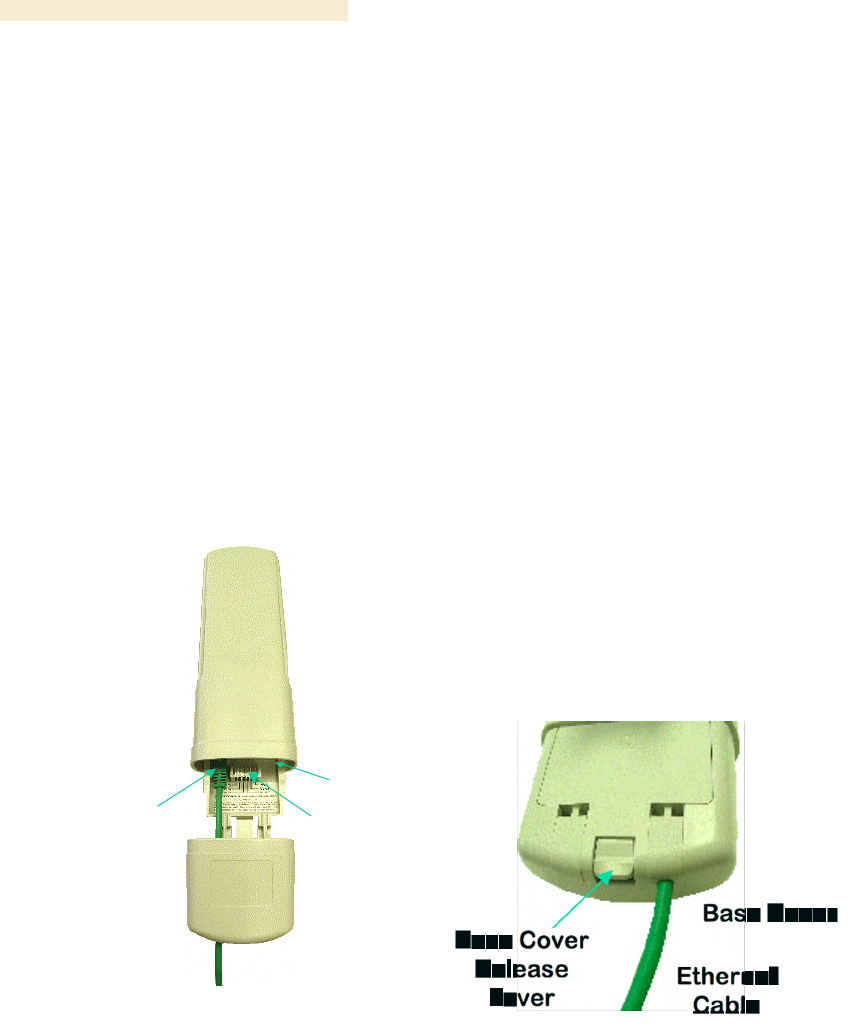
Installation and Configuration Guide Release 8
178 Draft 2 for Regulatory Review Issue 2, December 2006
16.2.2 Default Module Configuration
From the factory, the Canopy AP, SM, and BH are all configured to not transmit on any
frequency. This configuration ensures that you do not accidentally turn on an
unsynchronized module. Site synchronization of modules is required because
◦ Canopy modules
− cannot transmit and receive signals at the same time.
− use TDD (Time Division Duplexing) to distribute signal access of the
downlink and uplink frames.
◦ when one module transmits while an unintended module nearby receives signal,
the transmitting module may interfere with or desense the receiving module. In
this context, interference is self-interference (within the same Canopy network).
16.2.3 Component Layout
As shown in Figure 52, the base cover of the module snaps off when you depress a lever
on the back of the base cover. This exposes the Ethernet and GPS sync connectors and
diagnostic LEDs.
Figure 52: Canopy base cover, attached and detached
Ethernet
Cable
RJ45
Connector
Connection
LEDs
Base Cover
RJ11
Connector

Release 8 Installation and Configuration Guide
Issue 2, December 2006 Draft 2 for Regulatory Review 179
16.2.4 Diagnostic LEDs
The diagnostic LEDs report the following information about the status of the module.
Table 43 and Table 44 identify the LEDs in order of their left-to-right position as the cable
connections face downward.
NOTE:
The LED color helps you distinguish position of the LED. The LED color does
not indicate any status.
Table 43: LEDs in AP and BHM
Label
Color
when
Active
Status Information
Provided
Notes
LNK/5
green
Ethernet link
Continuously lit when link is present.
ACT/4
orange
Presence of data activity
on the Ethernet link
Flashes during data transfer. Frequency of flash is not a
diagnostic indication.
GPS/3
red
Pulse of sync
Continuously lit as pulse as AP receives pulse.
SES/2
green
Unused on the AP
SES is the session indicator on the CMM.
SYN/1
orange
Presence of sync
Always lit on the AP.
PWR
red
DC power
Always lit when power is correctly supplied.
Table 44: LEDs in SM and BHS
Notes
Label
Color
when
Active
Status if
Registered
Operating Mode
Aiming Mode
LNK/5
green
Ethernet link
Continuously lit when link is
present.
ACT/4
orange
Presence of data
activity on the
Ethernet link
Flashes during data transfer.
Frequency of flash is not a
diagnostic indication.
GPS/3
red
Unused
SES/2
green
Unused
SYN/1
orange
Presence of sync
If this module is not registered
to another, then these three
LEDs cycle on and off from left
to right.
These five LEDs act as a bar
graph to indicate the relative
quality of alignment. As power
level and jitter improve during
alignment, more of these
LEDs are lit.
PWR
red
DC power
Always lit when power is
correctly supplied.
Always lit when power is
correctly supplied.
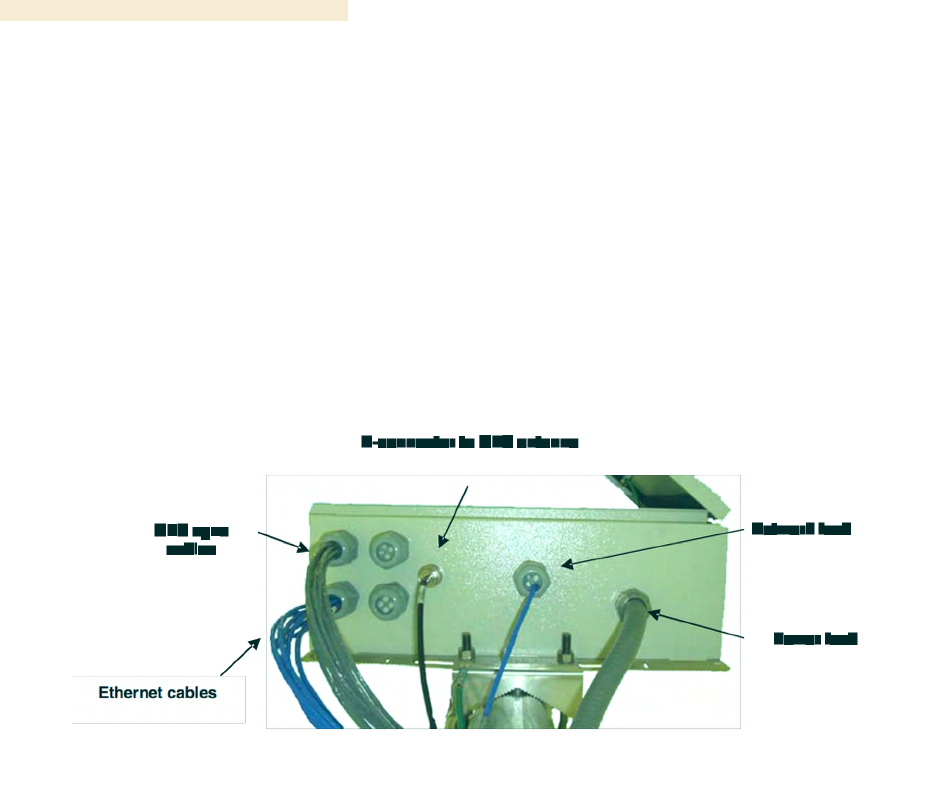
Installation and Configuration Guide Release 8
180 Draft 2 for Regulatory Review Issue 2, December 2006
16.2.5 CMM2 Component Layout
As shown in Figure 131 on Page 341, the CMM2 comprises four assemblies:
◦ Ethernet switch
◦ Power transformer
◦ Interconnect board
◦ GPS receiver.
Some CMM2s that were sold earlier had four openings in the bottom plate, as shown in
Figure 53. Currently available CMM2s have two additional Ethernet cable and GPS sync
cable openings to allow use of thicker, shielded cables.
Figure 53: Canopy CMM2, bottom view
16.2.6 CMMmicro Component Layout
The layout of the CMMmicro is shown in Figure 54.
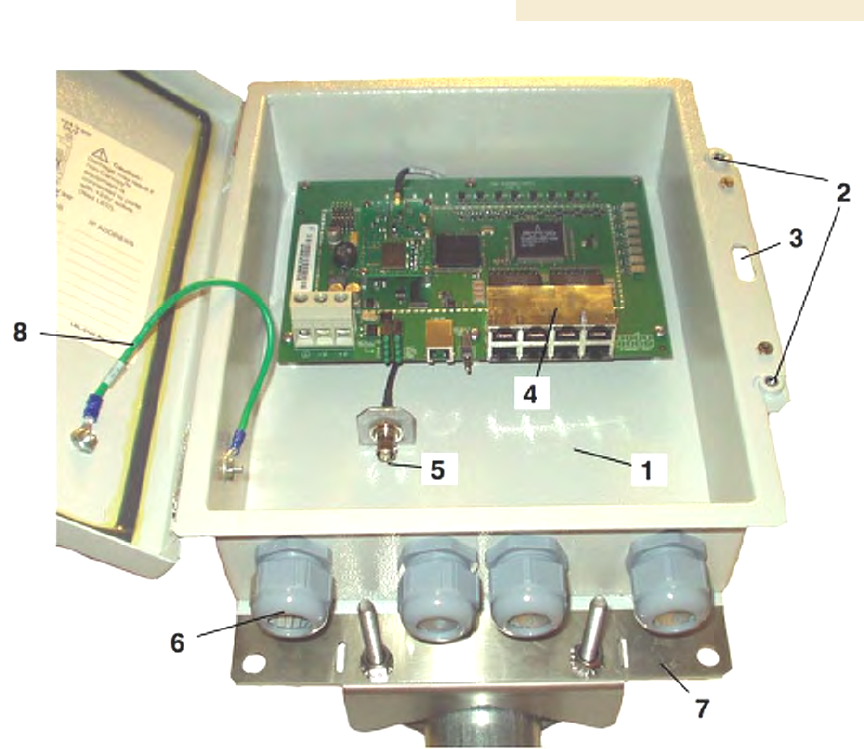
Release 8 Installation and Configuration Guide
Issue 2, December 2006 Draft 2 for Regulatory Review 181
LEGEND
1. Weatherized enclosure
2. Thumb-screw/slot-screwdriver door fasteners
3. Punch-out for padlock
4. Ethernet switch and power module
5. Female BNC connector
6. Water-tight bulkhead connectors
7. Flange for attachment (stainless steel for
grounding to tower or building) using U bolts
(provided) or other hardware such as screws, lag
bolts, or attachment straps (not provided)
8. Ground strap (for grounding door to enclosure)
9. 100-W 115/230-V AC to 24-V DC power
converter, with 10 ft (3 m) of DC power cable
(not shown)
10. 6-ft (1.8-m) AC power cord for 24 V power
converter (not shown)
Figure 54: Cluster Management Module micro

Installation and Configuration Guide Release 8
182 Draft 2 for Regulatory Review Issue 2, December 2006
16.2.7 Standards for Wiring
Canopy modules automatically sense whether the Ethernet cable in a connection is wired
as straight-through or crossover. You may use either straight-through or crossover cable
to connect a network interface card (NIC), hub, router, or switch to these modules. For a
straight-through cable, use the EIA/TIA-568B wire color-code standard on both ends. For
a crossover cable, use the EIA/TIA-568B wire color-code standard on one end, and the
EIA/TIA-568A wire color-code standard on the other end.
Where you use the Canopy AC wall adapter
◦ the power supply output is +24 VDC.
◦ the power input to the SM is +11.5 VDC to +30 VDC.
◦ the maximum Ethernet cable run is 328 feet (100 meters).
16.2.8 Best Practices for Cabling
The following practices are essential to the reliability and longevity of cabled connections:
◦ Use only shielded cables to resist interference.
◦ For vertical runs, provide cable support and strain relief.
◦ Include a 2-ft (0.6-m) service loop on each end of the cable to allow for thermal
expansion and contraction and to facilitate terminating the cable again when
needed.
◦ Include a drip loop to shed water so that most of the water does not reach the
connector at the device.
◦ Properly crimp all connectors.
◦ Use dielectric grease on all connectors to resist corrosion.
◦ Use only shielded connectors to resist interference and corrosion.
16.2.9 Recommended Tools for Wiring Connectors
The following tools may be needed for cabling the AP:
◦ RJ-11 crimping tool
◦ RJ-45 crimping tool
◦ electrician scissors
◦ wire cutters
◦ cable testing device.
16.2.10 Wiring Connectors
The following diagrams correlate pins to wire colors and illustrate crossovers where
applicable.
Location of Pin 1
Pin 1, relative to the lock tab on the connector of a straight-through cable is located as
shown below.
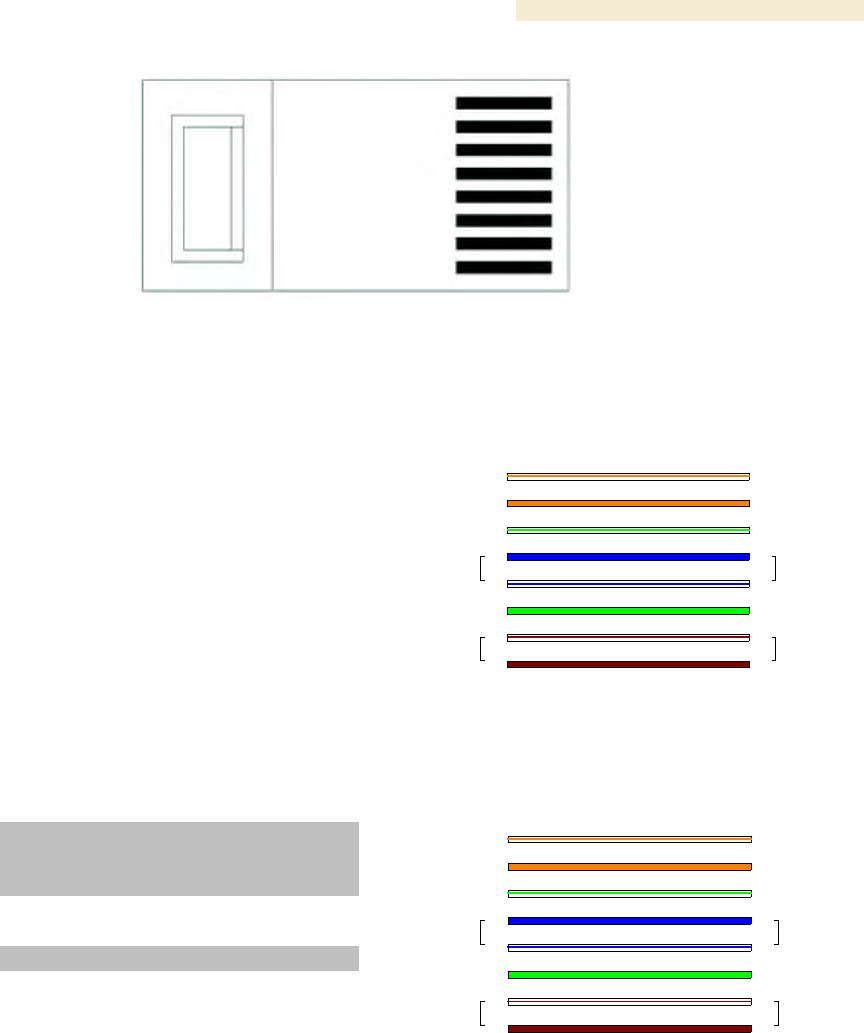
Release 8 Installation and Configuration Guide
Issue 2, December 2006 Draft 2 for Regulatory Review 183
Lock tab ↑ underneath
← Pin 1
RJ-45 Pinout for Straight-through Ethernet Cable
Pin 1 → white / orange ← Pin 1
Pin 2 → orange ← Pin 2
Pin 3 → white / green ← Pin 3
Pin 4 → blue ← Pin 4
Pin 5 → white / blue ← Pin 5
Pin 6 → green ← Pin 6
Pin 7 → white / brown ← Pin 7
Pin 8 → brown ← Pin 8
Pins 7 and 8 carry power to the
modules.
1
2
3
4
5
6
7
8
1
2
3
4
5
6
7
8
TX+
TX-
RX+
RX-
TX-
TX-
RX+
RX-
+V return
+V
Pin PinRJ-45 Straight-thru
+V return
+V
Figure 55: RJ-45 pinout for straight-through Ethernet cable
RJ-45 Pinout for Crossover Ethernet Cable
Pin 1 → white / orange ← Pin 3
Pin 2 → orange ← Pin 6
Pin 3 → white / green ← Pin 1
Pin 4 → blue ← Pin 4
Pin 5 → white / blue ← Pin 5
Pin 6 → green ← Pin 2
Pin 7 → white / brown ← Pin 7
Pin 8 → brown ← Pin 8
Pins 7 and 8 carry power to the modules.
7
8
TX+
TX-
RX+
RX-
3
6
1
4
5
2
7
8
RX+
RX-
TX+
TX-
1
2
3
4
5
6
+V
return
+V +V
+V
return
Pin PinRJ-45 Crossover
Figure 56: RJ-45 pinout for crossover Ethernet cable
RJ-11 Pinout for Straight-through Sync Cable
The Canopy system uses a utility cable with RJ-11 connectors between the AP or BH
and synchronization pulse. Presuming CAT 5 cable and 6-pin RJ-11 connectors, the
following diagram shows the wiring of the cable for sync.
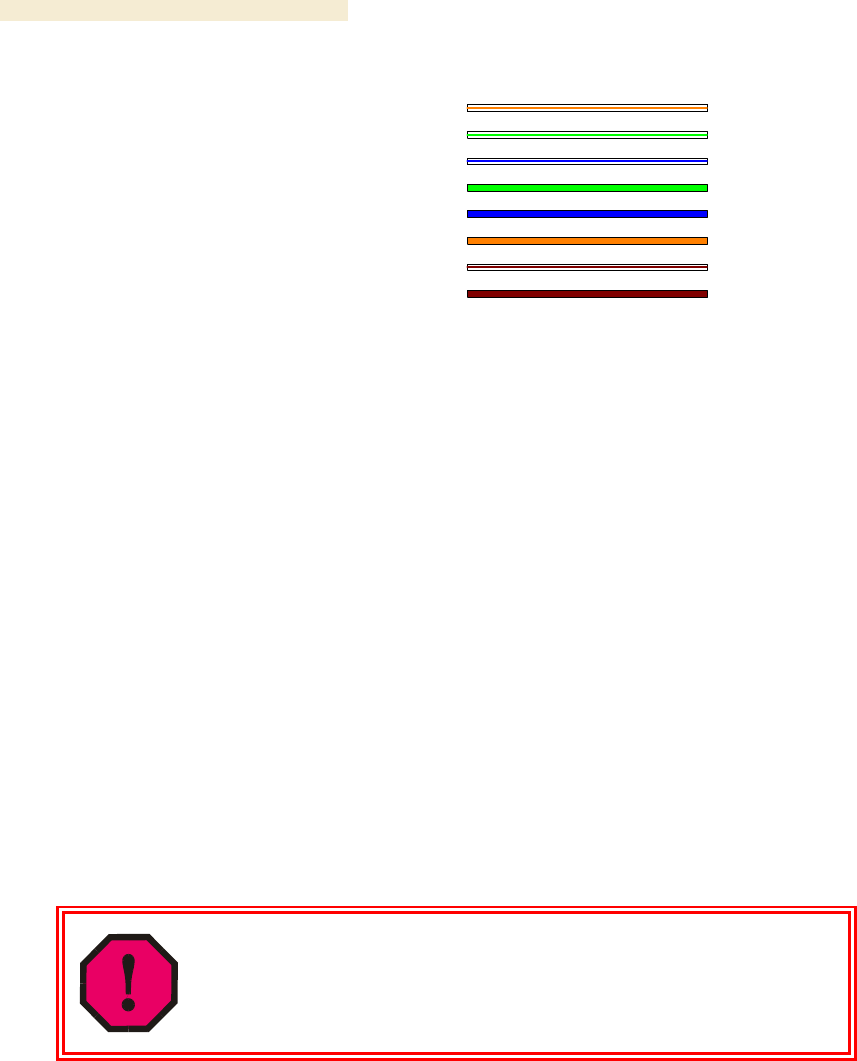
Installation and Configuration Guide Release 8
184 Draft 2 for Regulatory Review Issue 2, December 2006
Pin 1 → white / orange ← Pin 1
Pin 2 → white / green ← Pin 2
Pin 3 → white / blue ← Pin 3
Pin 4 → green ← Pin 4
Pin 5 → blue ← Pin 5
Pin 6 → orange ← Pin 6
NOTE: The fourth pair is not
used.
Figure 57: RJ-11 pinout for straight-through sync cable
16.2.11 Alignment Tone—Technical Details
The alignment tone output from a Canopy module is available on Pin 5 of the RJ-11
connector, and ground is available on Pin 6. Thus the load at the listening device should
be between Pins 5 and 6. The listening device may be a headset, earpiece, or battery-
powered speaker.
16.3 CONFIGURING A POINT-TO-MULTIPOINT LINK FOR TEST
Perform the following steps to begin the test setup.
Procedure 5: Setting up the AP for Quick Start
1. In one hand, securely hold the top (larger shell) of the AP. With the other hand,
depress the lever in the back of the base cover (smaller shell). Remove the base
cover.
2. Plug one end of a CAT 5 Ethernet cable into the AP.
3. Plug the Ethernet cable connector labeled To Radio into the jack in the pig tail
that hangs from the power supply.
WARNING!
From this point until you remove power from the AP, stay at least as far from the
AP as the minimum separation distance specified under Preventing
Overexposure to RF on Page 169.
4. Plug the other connector of the pig tail (this connector labeled To Computer) into
the Ethernet jack of the computing device.
5. Plug the power supply into an electrical outlet.
6. Power up the computing device.
7. Start the browser in the computing device.
=========================== end of procedure ===========================
1
2
3
4
5
6
1
2
3
4
5
6
sync pulse
serial transmit
serial receive
sync pulse
serial receive
serial transmit
override plug
alignment tone
override plug
alignment tone
not
used
not
used
Pin
Pin
RJ-11 Straight-Thru
Protective Earth (PE)
(ground)
Protective Earth (PE)
(ground)

Release 8 Installation and Configuration Guide
Issue 2, December 2006 Draft 2 for Regulatory Review 185
The Canopy AP interface provides a series of web pages to configure and monitor the
unit. You can access the web-based interface through a computing device that is either
directly connected or connected through a network to the AP. If the computing device is
not connected to a network when you are configuring the module in your test
environment, and if the computer has used a proxy server address and port to configure
a Canopy module, then you may need to first disable the proxy setting in the computer.
Perform the following procedure to toggle the computer to not use the proxy setting.
Procedure 6: Bypassing proxy settings to access module web pages
1. Launch Microsoft Internet Explorer.
2. Select ToolsInternet OptionsConnectionsLAN Settings.
3. Uncheck the Use a proxy server… box.
NOTE: If you use an alternate web browser, the menu selections differ from the
above.
=========================== end of procedure ===========================
In the address bar of your browser, enter the IP address of the AP. (For example, enter
http://169.254.1.1 to access the AP through its default IP address). The AP
responds by opening the General Status tab of its Home page.
16.3.1 Quick Start Page of the AP
To proceed with the test setup, click the Quick Start button on the left side of the
General Status tab. The AP responds by opening the Quick Start page. The Quick Start
tab of that page is displayed in Figure 58.
NOTE:
If you cannot find the IP address of the AP, see Override Plug on Page 60.
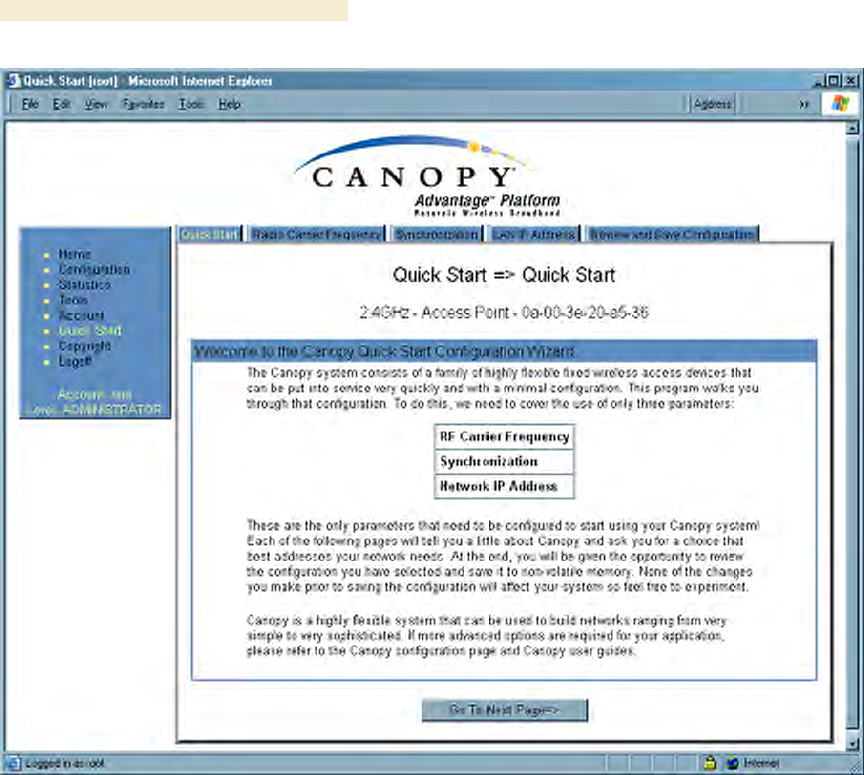
Installation and Configuration Guide Release 8
186 Draft 2 for Regulatory Review Issue 2, December 2006
Figure 58: Quick Start tab of AP, example
Quick Start is a wizard that helps you to perform a basic configuration that places an AP
into service. Only the following parameters must be configured:
◦ RF Carrier Frequency
◦ Synchronization
◦ Network IP Address
In each Quick Start tab, you can
◦ specify the settings to satisfy the requirements of the network.
◦ review the configuration selected.
◦ save the configuration to non-volatile memory.
Proceed with the test setup as follows.
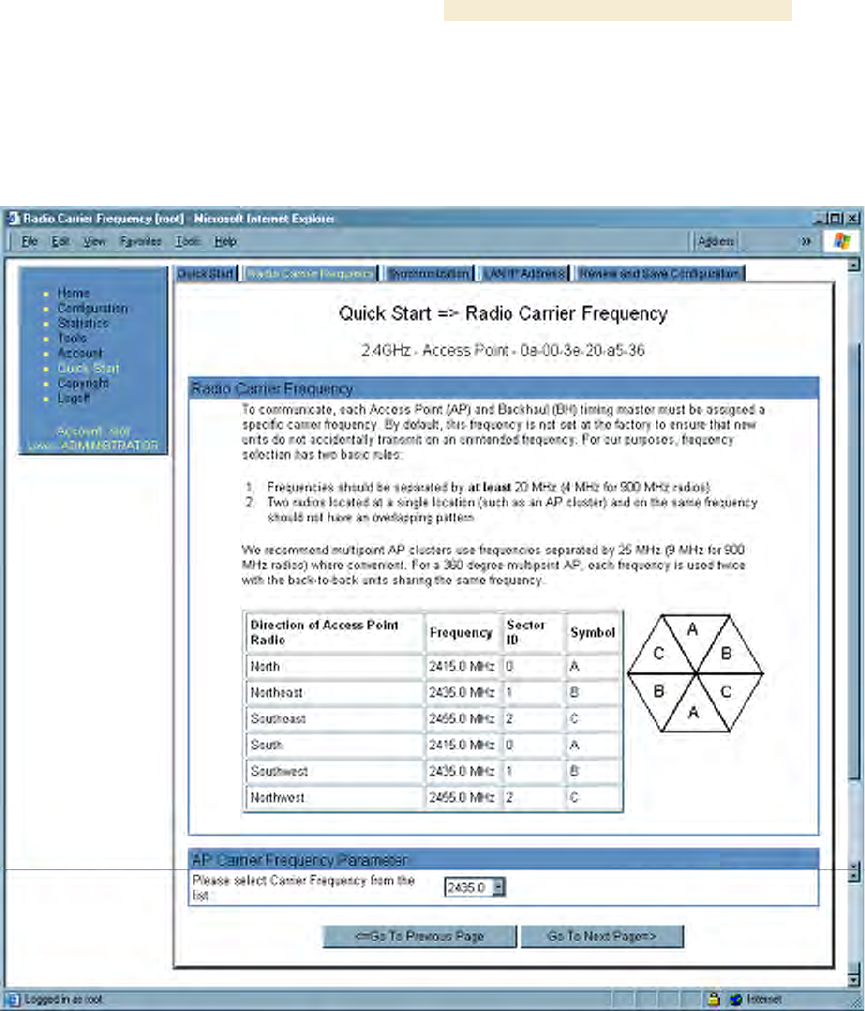
Release 8 Installation and Configuration Guide
Issue 2, December 2006 Draft 2 for Regulatory Review 187
Procedure 7: Using Quick Start to configure a standalone AP for test
1. At the bottom of the Quick Start tab, click the Go To Next Page => button.
RESULT: The AP responds by opening the RF Carrier Frequency tab.
An example of this tab is shown in Figure 59.
Figure 59: Radio Frequency Carrier tab of AP, example
2. From the pull-down menu in the lower left corner of this tab, select a frequency
for the test.
3. Click the Go To Next Page => button.
RESULT: The AP responds by opening the Synchronization tab. An example of
this tab is shown in Figure 60.
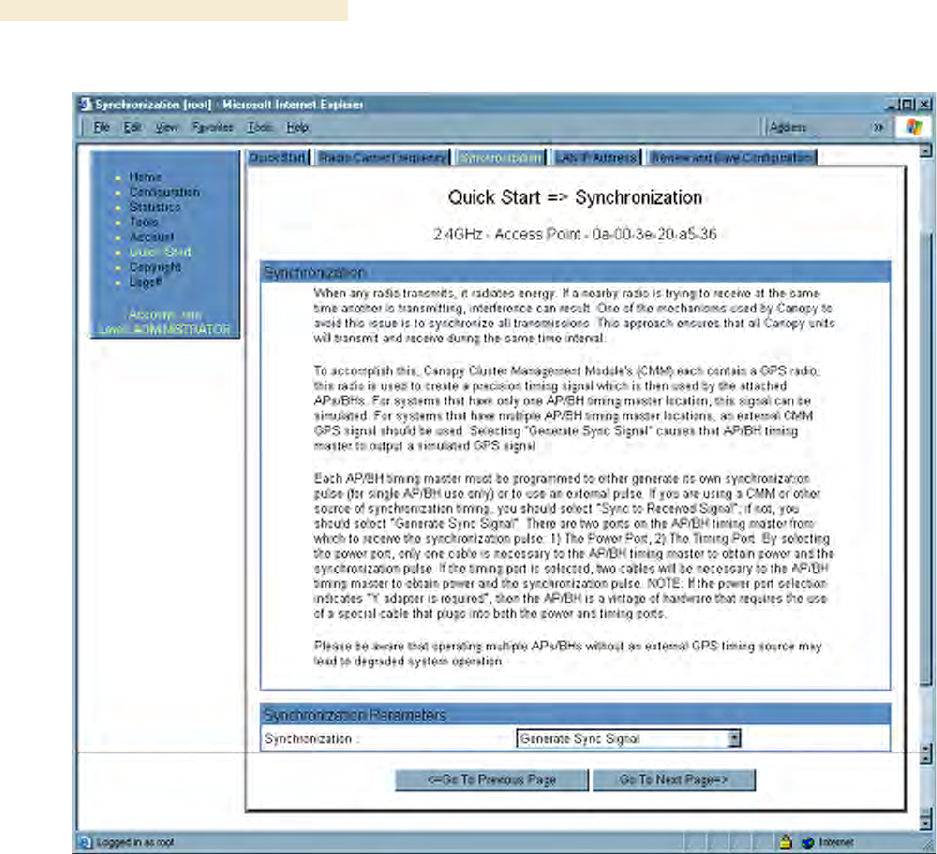
Installation and Configuration Guide Release 8
188 Draft 2 for Regulatory Review Issue 2, December 2006
Figure 60: Synchronization tab of AP, example
4. At the bottom of this tab, select Generate Sync Signal.
5. Click the Go To Next Page => button.
RESULT: The AP responds by opening the LAN IP Address tab. An example of
this tab is shown in Figure 61.
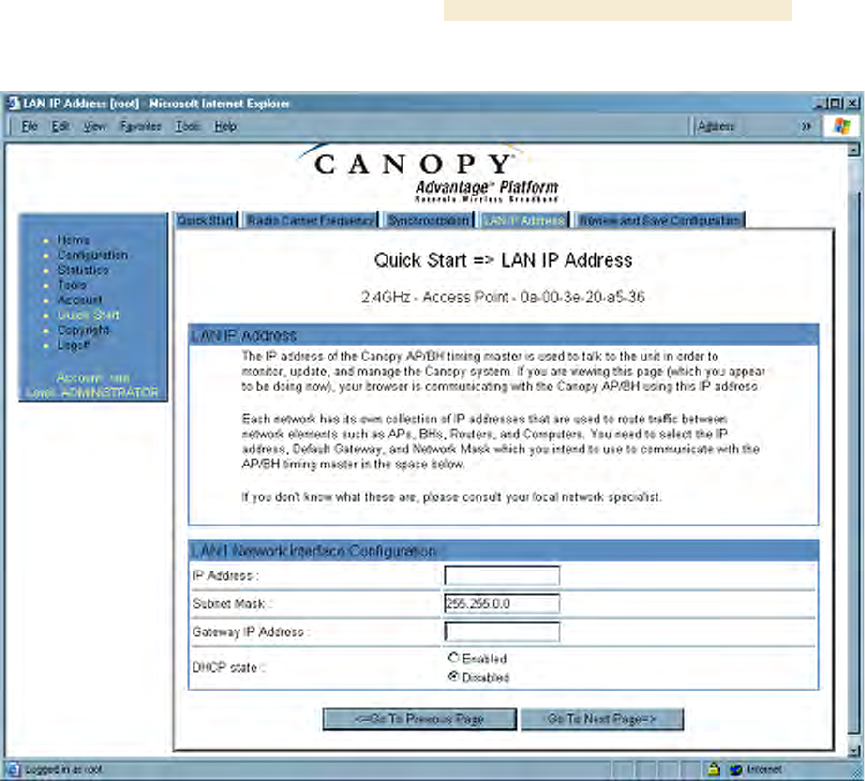
Release 8 Installation and Configuration Guide
Issue 2, December 2006 Draft 2 for Regulatory Review 189
Figure 61: LAN IP Address tab of AP, example
6. At the bottom of this tab, either
◦ specify an IP Address, a Subnet Mask, and a Gateway IP Address for
management of the AP and leave the DHCP state set to Disabled.
◦ set the DHCP state to Enabled to have the IP address, subnet mask, and
gateway IP address automatically configured by a domain name server
(DNS).
7. Click the Go To Next Page => button.
RESULT: The AP responds by opening the Review and Save Configuration tab.
An example of this tab is shown in Figure 62.
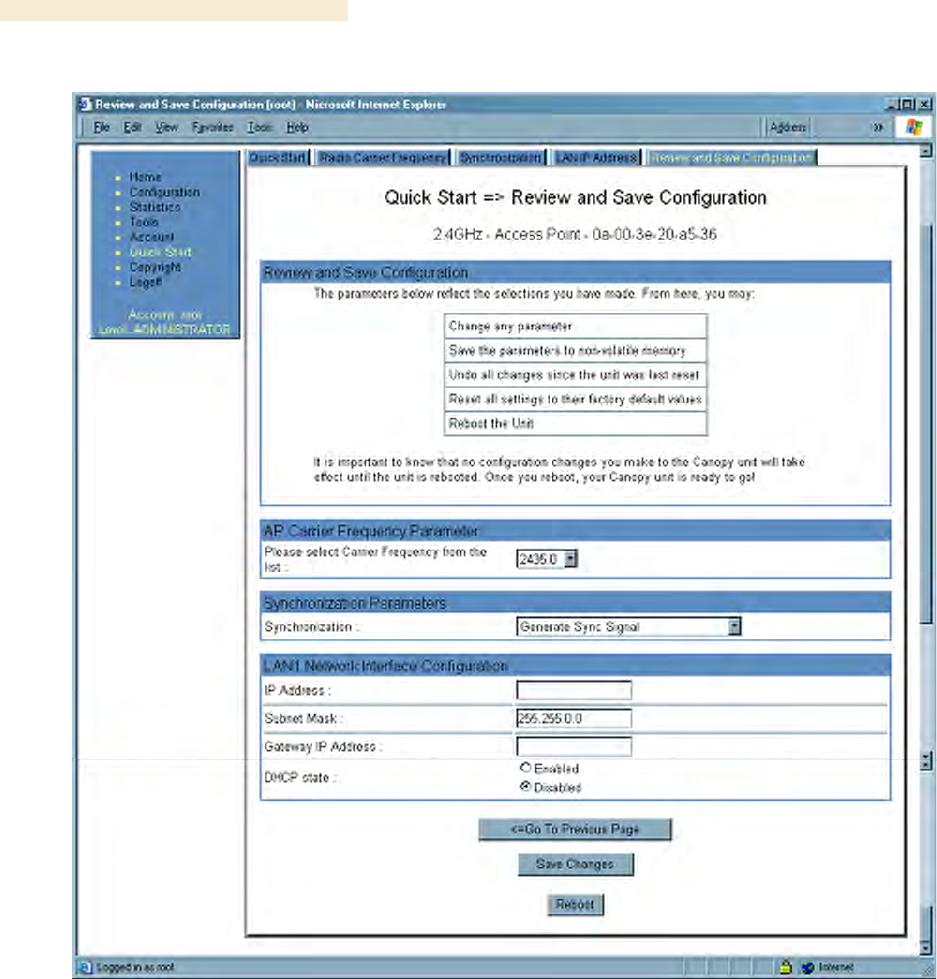
Installation and Configuration Guide Release 8
190 Draft 2 for Regulatory Review Issue 2, December 2006
Figure 62: Review and Save Configuration tab of AP, example
8. Ensure that the initial parameters for the AP are set as you intended.
9. Click the Save Changes button.
10. Click the Reboot button.
RESULT: The AP responds with the message Reboot Has Been Initiated…
11. Wait until the indicator LEDs are not red.
12. Trigger your browser to refresh the page until the AP redisplays the General
Status tab.
13. Wait until the red indicator LEDs are not lit.
=========================== end of procedure ===========================
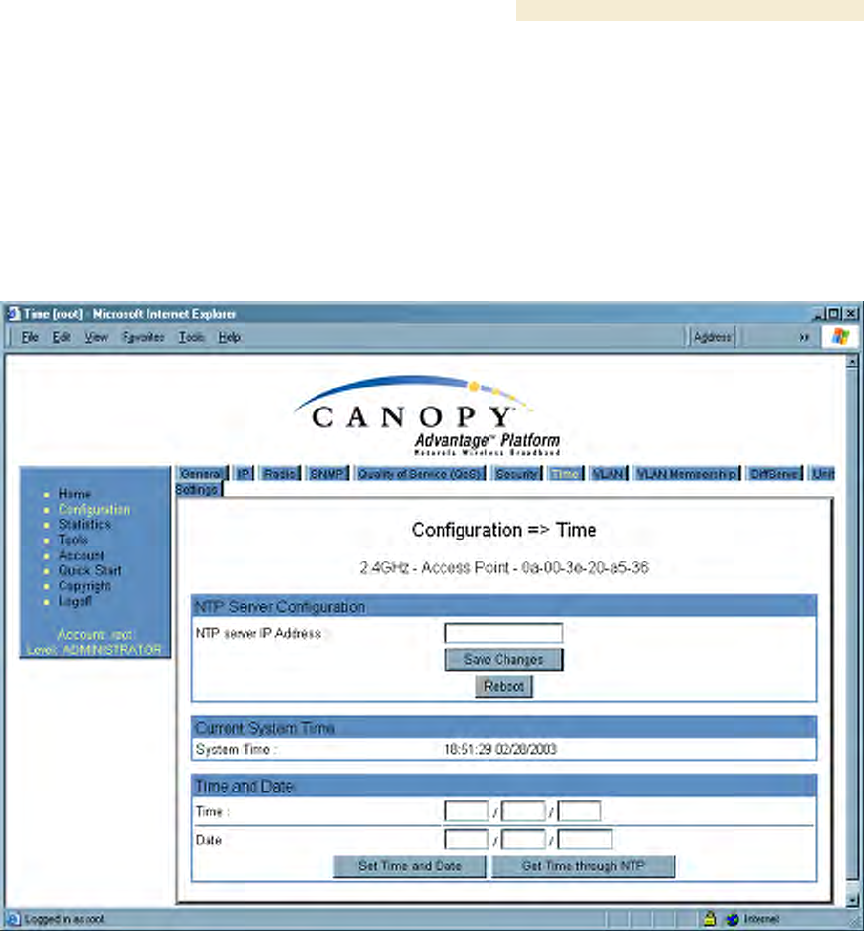
Release 8 Installation and Configuration Guide
Issue 2, December 2006 Draft 2 for Regulatory Review 191
Canopy encourages you to experiment with the interface. Unless you save a
configuration and reboot the AP after you save the configuration, none of the changes
are effected.
16.3.2 Time Tab of the AP
To proceed with the test setup, click the Configuration link on the left side of the General
Status tab. When the AP responds by opening the Configuration page to the General tab,
click the Time tab. An example of this tab is displayed in Figure 63.
Figure 63: Time tab of AP, example
To have each log in the AP correlated to a meaningful time and date, either a reliable
network element must pass time and date to the AP or you must set the time and date
whenever a power cycle of the AP has occurred. A network element passes time and
date in any of the following scenarios:
◦ A connected CMM2 passes time and date (GPS time and date, if received).
◦ A connected CMMmicro passes the time and date (GPS time and date, if
received), but only if both the CMMmicro is operating on CMMmicro Release 2.1
or later release. (These releases include an NTP server functionality.)
◦ A separate NTP server is addressable from the AP.
If the AP should obtain time and date from either a CMMmicro or a separate NTP server,
enter the IP address of the CMMmicro or NTP server on this tab. To force the AP to
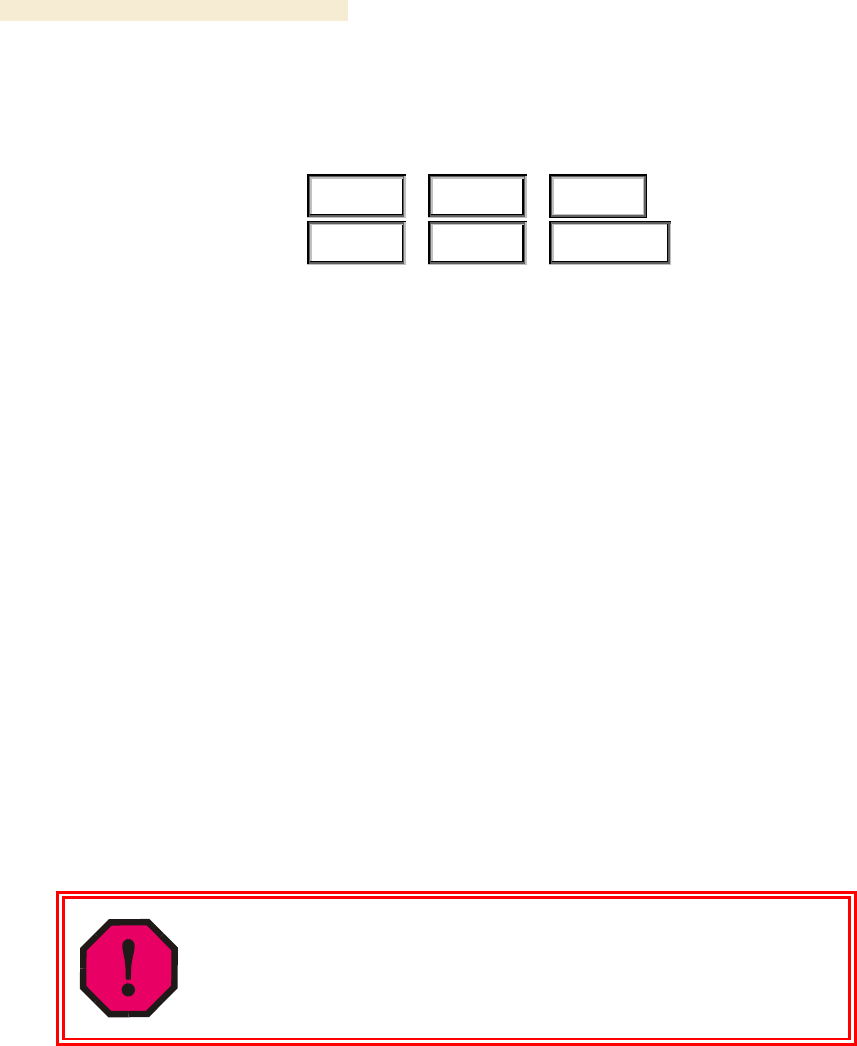
Installation and Configuration Guide Release 8
192 Draft 2 for Regulatory Review Issue 2, December 2006
obtain time and date before the first (or next) 15-minute interval query of the NTP server,
click Get Time through NTP.
If you enter a time and date, the format for entry is
Time :
hh
/
mm
/
ss
Date :
MM
/
dd
/
yyyy
where
hh
represents the two-digit hour in the range 00 to 24
mm
represents the two-digit minute
ss
represents the two-digit second
MM
represents the two-digit month
dd
represents the two-digit day
yyyy
represents the four-digit year
Proceed with the test setup as follows.
◦ Enter the appropriate information in the format shown above.
◦ Then click the Set Time and Date button.
NOTE: The time displayed at the top of this page is static unless your browser is
set to automatically refresh.
Procedure 8: Setting up the SM for test
1. In one hand, securely hold the top (larger shell) of the SM. With the other hand,
depress the lever in the back of the base cover (smaller shell). Remove the base
cover.
2. Plug one end of a CAT 5 Ethernet cable into the SM RJ-45 jack.
3. Plug the other end of the Ethernet cable into the jack in the pig tail that hangs
from the power supply.
4. Roughly aim the SM toward the AP.
WARNING!
From this point until you remove power from the SM, stay at least as far from the
SM as the minimum separation distance specified under Preventing
Overexposure to RF on Page 169.
5. Plug the power supply into an electrical outlet.
6. Repeat the foregoing steps for each SM that you wish to include in the test.
7. Back at the computing device, on the left side of the Time & Date tab, click
Home.
8. Click the Session Status tab.
=========================== end of procedure ===========================
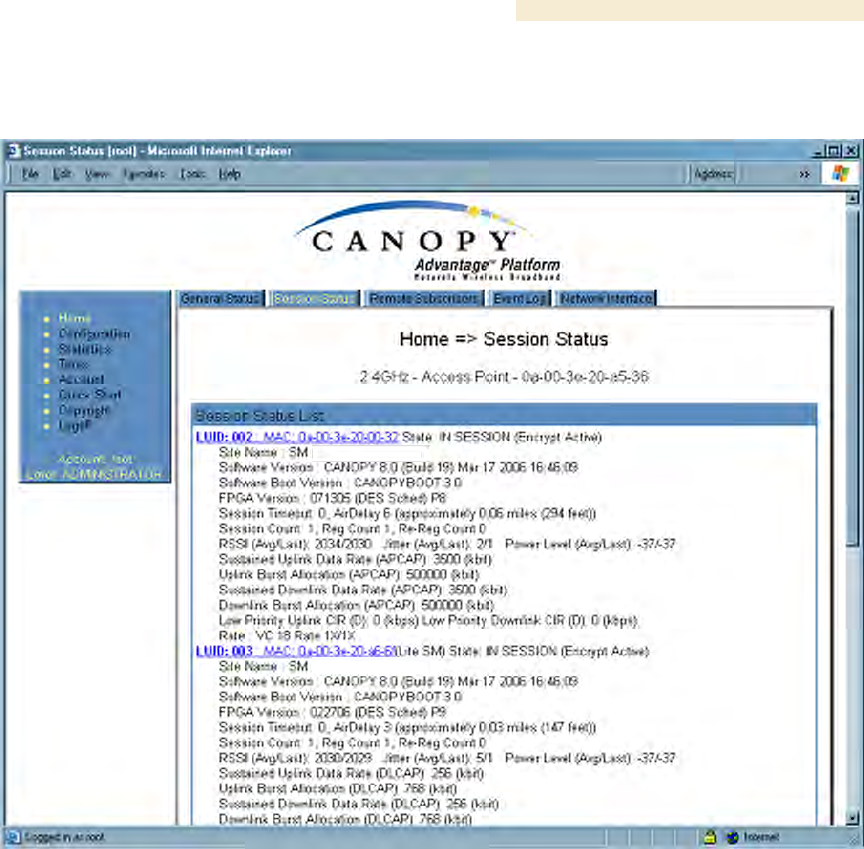
Release 8 Installation and Configuration Guide
Issue 2, December 2006 Draft 2 for Regulatory Review 193
16.3.3 Session Status Tab of the AP
An example of the AP Session Status tab is displayed in Figure 64.
Figure 64: Session Status tab data from AP, example
If no SMs are registered to this AP, then the Session Status tab displays the simple
message No sessions. In this case, try the following steps.
Procedure 9: Retrying to establish a point-to-multipoint link
1. More finely aim the SM or SMs toward the AP.
2. Recheck the Session Status tab of the AP for the presence of LUIDs.
3. If still no LUIDs are reported on the Session Status tab, click the Configuration
button on the left side of the Home page.
RESULT: The AP responds by opening the AP Configuration page.
4. Click the Radio tab.
5. Find the Color Code parameter and note the setting.
6. In the same sequence as you did for the AP directly under Configuring a Point-to-
Multipoint Link for Test on Page 184, connect the SM to a computing device and
to power.
7. On the left side of the SM Home page, click the Configuration button.
RESULT: The Configuration page of the SM opens.

Installation and Configuration Guide Release 8
194 Draft 2 for Regulatory Review Issue 2, December 2006
8. Click the Radio tab.
9. If the transmit frequency of the AP is not selected in the Custom Radio
Frequency Scan Selection List parameter, select the frequency that matches.
10. If the Color Code parameter on this page is not identical to the Color Code
parameter you noted from the AP, change one of them so that they match.
11. At the bottom of the Radio tab for the SM, click the Save Changes button.
12. Click the Reboot button.
13. Allow several minutes for the SM to reboot and register to the AP.
14. Return to the computing device that is connected to the AP.
15. Recheck the Session Status tab of the AP for the presence of LUIDs.
=========================== end of procedure ===========================
The Session Status tab provides information about each SM that has registered to
the AP. This information is useful for managing and troubleshooting a Canopy system.
All information that you have entered in the Site Name field of the SM displays in the
Session Status tab of the linked AP.
The Session Status tab also includes the current active values on each SM (LUID) for
MIR, CIR, and VLAN, as well as the source of these values (representing the SM itself,
BAM, or the AP and cap, if any—for example, APCAP as shown in Figure 64 above).
L indicates a Canopy Lite SM, and D indicates from the device. As an SM registers to
the AP, the configuration source that this page displays for the associated LUID may
change. After registration, however, the displayed source is stable and can be trusted.
The Session Status tab of the AP provides the following parameters.
LUID
This field displays the LUID (logical unit ID) of the SM. As each SM registers to the AP,
the system assigns an LUID of 2 or a higher unique number to the SM. If an SM loses
registration with the AP and then regains registration, the SM will retain the same LUID.
NOTE:
The LUID association is lost when a power cycle of the AP occurs.
MAC
This field displays the MAC address (or electronic serial number) of the SM.
State
This field displays the current status of the SM as either
◦ IN SESSION to indicate that the SM is currently registered to the AP.
◦ IDLE to indicate that the SM was registered to the AP at one time, but now is not.
This field also indicates whether the encryption scheme in the module is enabled.

Release 8 Installation and Configuration Guide
Issue 2, December 2006 Draft 2 for Regulatory Review 195
Site Name
This field indicates the name of the SM. You can assign or change this name on the
Configuration web page of the SM. This information is also set into the sysName SNMP
MIB-II object and can be polled by an SNMP management server.
Software Version
This field displays the software release that operates on the SM, the release date and
time of the software.
Software Boot Version
This field indicates the CANOPYBOOT version number.
FPGA Version
This field displays the version of FPGA that runs on the SM.
Session Timeout
This field displays the timeout in seconds for management sessions via HTTP, telnet, or
ftp access to the SM. 0 indicates that no limit is imposed.
AirDelay
This field displays the distance of the SM from the AP. To derive the distance in meters,
multiply the displayed number by 0.3048. At close distances, the value in this field is
unreliable.
Session Count
This field displays how many sessions the SM has had with the AP. Typically, this is the
sum of Reg Count and Re-Reg Count. However, the result of internal calculation may
display here as a value that slightly differs from the sum.
If the number of sessions is significantly greater than the number for other SMs, then this
may indicate a link problem or an interference problem.
Reg Count
When an SM makes a registration request, the AP checks its local data to see whether it
considers the SM to be already registered. If the AP concludes that the SM is not, then
the request increments the value of this field.
Re-Reg Count
When an SM makes a registration request, the AP checks its local data to see whether it
considers the SM to be already registered. If the AP concludes that the SM is not, then
the request increments the value of this field. Typically, a Re-Reg is the case where both
◦ an SM attempts to reregister for having lost communication with the AP.
◦ the AP has not yet observed the link to the SM as being down.
A high number in this field is often an indication of link instability or interference problems.
RSSI, Jitter, and Power Level (Avg/Last)
The Session Status tab shows the received Power Level in dBm and Jitter. Proper
alignment maximizes Power Level and minimizes Jitter. As you refine alignment, you
should favor lower jitter over higher dBm. For example, if coarse alignment gives an SM
a power level of −75 dBm and a jitter measurement of 5, and further refining

Installation and Configuration Guide Release 8
196 Draft 2 for Regulatory Review Issue 2, December 2006
the alignment drops the power level to −78 dBm and the jitter to 2 or 3, use the refined
alignment, with the following caveats:
◦ When the receiving link is operating at 1X, the Jitter scale is 0 to 15 with desired
jitter between 0 and 4.
◦ When the receiving link is operating at 2X, the Jitter scale is 0 to 15 with desired
jitter between 0 and 9.
For historical relevance, the Session Status tab also shows the RSSI, the unitless
measure of power. Use Power Level and ignore RSSI. RSSI implies more accuracy and
precision than is inherent in its measurement.
Sustained Uplink Data Rate
This field displays the value that is currently in effect for the SM, with the source of that
value in parentheses. This is the specified rate at which each SM registered to this AP is
replenished with credits for transmission. The configuration source of the value is
indicated in parentheses. See
◦ Maximum Information Rate (MIR) Parameters on Page 86
◦ Interaction of Burst Allocation and Sustained Data Rate Settings on Page 88
◦ Setting the Configuration Source on Page 292.
Uplink Burst Allocation
This field displays the value that is currently in effect for the SM, with the source of that
value in parentheses. This is the specified maximum amount of data that each SM is
allowed to transmit before being recharged at the Sustained Uplink Data Rate with
credits to transmit more. The configuration source of the value is indicated in
parentheses. See
◦ Maximum Information Rate (MIR) Parameters on Page 86
◦ Interaction of Burst Allocation and Sustained Data Rate Settings on Page 88
◦ Setting the Configuration Source on Page 292.
Sustained Downlink Data Rate
This field displays the value that is currently in effect for the SM, with the source of that
value in parentheses. This is the specified the rate at which the AP should be replenished
with credits (tokens) for transmission to each of the SMs in its sector. The configuration
source of the value is indicated in parentheses. See
◦ Maximum Information Rate (MIR) Parameters on Page 86
◦ Interaction of Burst Allocation and Sustained Data Rate Settings on Page 88
◦ Setting the Configuration Source on Page 292.
Downlink Burst Allocation
This field displays the value that is currently in effect for the SM, with the source of that
value in parentheses. This is the maximum amount of data to allow the AP to transmit to
any registered SM before the AP is replenished with transmission credits at the
Sustained Downlink Data Rate. The configuration source of the value is indicated in
parentheses. See
◦ Maximum Information Rate (MIR) Parameters on Page 86
◦ Interaction of Burst Allocation and Sustained Data Rate Settings on Page 88
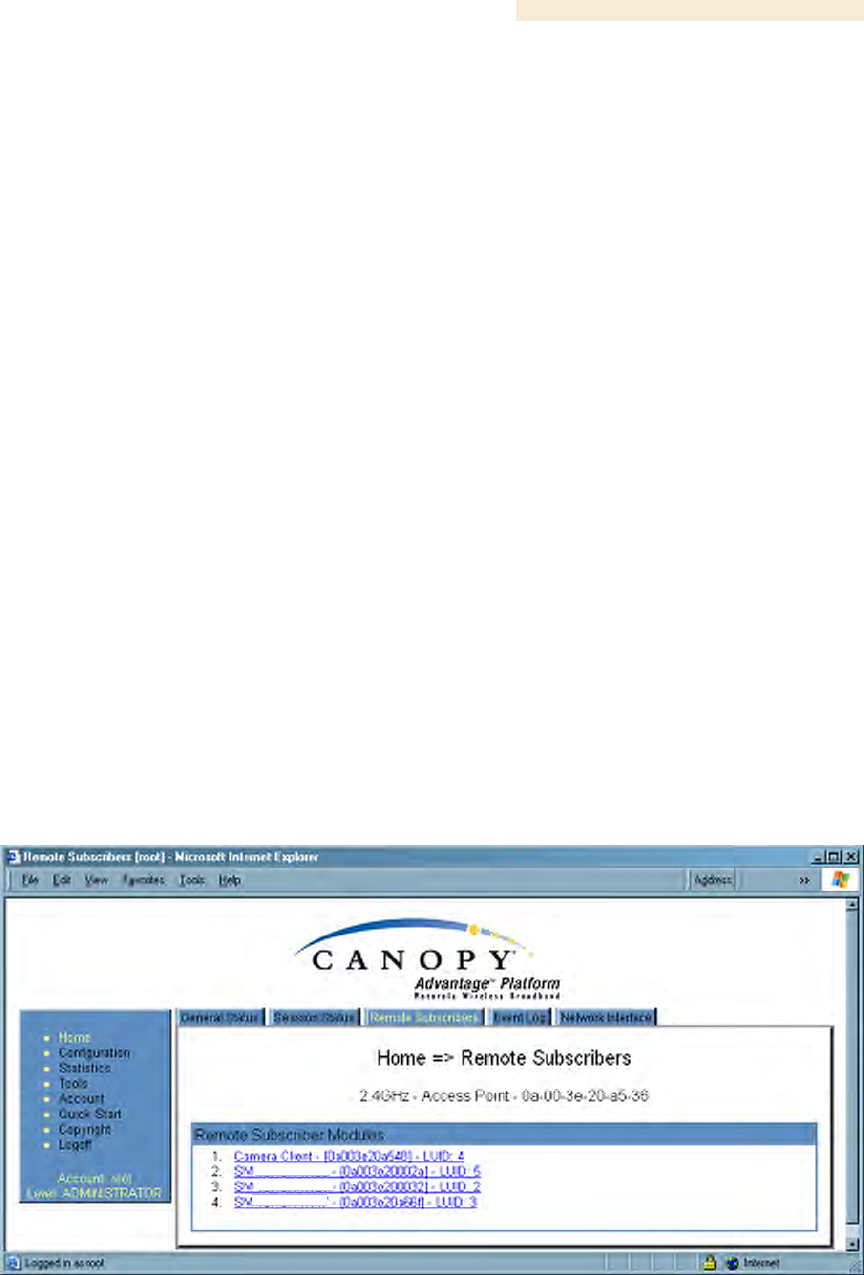
Release 8 Installation and Configuration Guide
Issue 2, December 2006 Draft 2 for Regulatory Review 197
◦ Setting the Configuration Source on Page 292.
Low Priority Uplink CIR
This field displays the value that is currently in effect for the SM, with the source of that
value in parentheses. The configuration source of the value is indicated in parentheses.
See
◦ Committed Information Rate on Page 88
◦ Setting the Configuration Source on Page 292.
Low Priority Downlink CIR
This field displays the value that is currently in effect for the SM, with the source of that
value in parentheses. The configuration source of the value is indicated in parentheses.
See
◦ Committed Information Rate on Page 88
◦ Setting the Configuration Source on Page 292.
Rate
This field displays whether the high-priority channel is enabled in the SM and the status
of 1X or 2X operation in the SM. See Checking the Status of 2X Operation on Page 93.
16.3.4 Beginning the Test of Point-to-Multipoint Links
To begin the test of links, perform the following steps:
1. In the Session Status tab of the AP, note the LUID associated with the MAC
address of any SM you wish to involve in the test.
2. Click the Remote Subscribers tab.
16.3.5 Remote Subscribers Tab of the AP
An example of a Remote Subscribers tab is displayed in Figure 65.
Figure 65: Remote Subscribers tab of AP, example
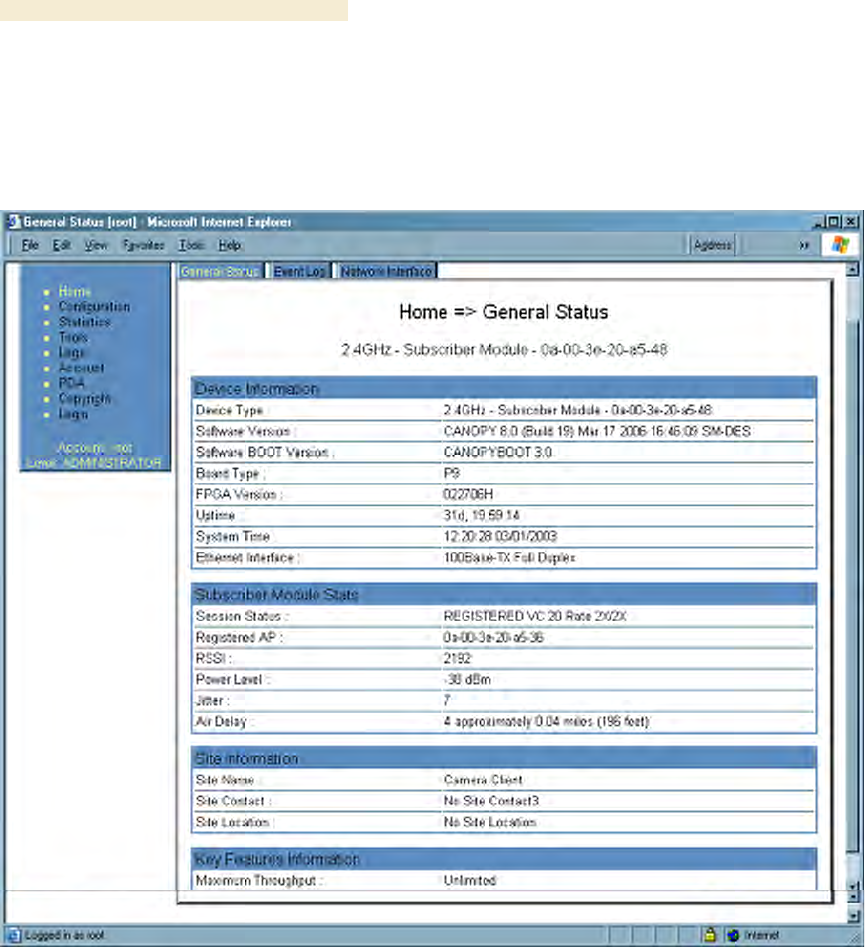
Installation and Configuration Guide Release 8
198 Draft 2 for Regulatory Review Issue 2, December 2006
This tab allows you to view the web pages of registered SMs over the RF link. To view
the pages for a selected SM, click its link. The General Status tab of the SM opens.
16.3.6 General Status Tab of the SM
An example of the General Status tab of an SM is displayed in Figure 66.
Figure 66: General Status tab of SM, example
The General Status tab provides information on the operation of this SM. This is the tab
that opens by default when you access the GUI of the SM. The General Status tab
provides the following read-only fields.
Device Type
This field indicates the type of the Canopy module. Values include the frequency band of
the SM, its module type, and its MAC address.
Software Version
This field indicates the Canopy system release, the time and date of the release, and
whether communications involving the module are secured by DES or AES encryption
(see Encrypting Canopy Radio Transmissions on Page 371). If you request technical
support, provide the information from this field.

Release 8 Installation and Configuration Guide
Issue 2, December 2006 Draft 2 for Regulatory Review 199
Software BOOT Version
This field indicates the version of the CANOPYBOOT file. If you request technical
support, provide the information from this field.
Board Type
This field indicates the series of hardware. See Designations for Hardware in Radios on
Page 367.
FPGA Version
This field indicates the version of the field-programmable gate array (FPGA) on the
module. When you request technical support, provide the information from this field.
Uptime
This field indicates how long the module has operated since power was applied.
System Time
This field provides the current time. Any SM that registers to an AP inherits the system
time, which is displayed in this field as GMT (Greenwich Mean Time).
Ethernet Interface
This field indicates the speed and duplex state of the Ethernet interface to the SM.
Session Status
This field displays the following information about the current session:
◦ Scanning indicates that this SM currently cycles through the radio frequencies
that are selected in the Radio tab of the Configuration page.
◦ Syncing indicates that this SM currently attempts to receive sync.
◦ Registering indicates that this SM has sent a registration request message to
the AP and has not yet received a response.
◦ Registered indicates that this SM is both
− registered to an AP.
− ready to transmit and receive data packets.
◦ Alignment indicates that this SM is in an aiming mode. See Table 44 on
Page 179.
Registered AP
This field displays the MAC address of the AP to which this SM is registered.
RSSI, Power Level, and Jitter
The General Status tab shows the received Power Level in dBm and Jitter. Proper
alignment maximizes Power Level and minimizes Jitter. As you refine alignment, you
should favor lower jitter over higher dBm. For example, if coarse alignment gives an SM
a power level of −75 dBm and a jitter measurement of 5, and further refining
the alignment drops the power level to −78 dBm and the jitter to 2 or 3, use the refined
alignment, with the following caveats:
◦ When the receiving link is operating at 1X, the Jitter scale is 0 to 15 with desired
jitter between 0 and 4.
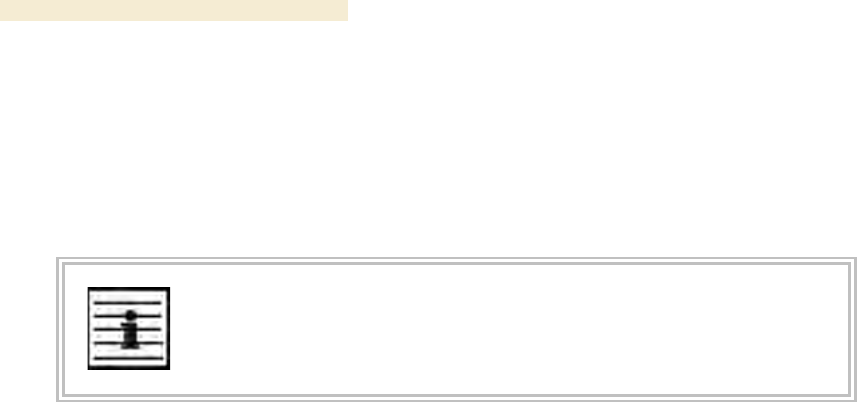
Installation and Configuration Guide Release 8
200 Draft 2 for Regulatory Review Issue 2, December 2006
◦ When the receiving link is operating at 2X, the Jitter scale is 0 to 15 with desired
jitter between 0 and 9.
For historical relevance, the General Status tab also shows the RSSI, the unitless
measure of power. Use Power Level and ignore RSSI. RSSI implies more accuracy and
precision than is inherent in its measurement.
NOTE:
Unless the page is set to auto-refresh, the values displayed are from the instant
the General Status tab was selected. To keep a current view of the values,
refresh the browser screen or set to auto-refresh.
Air Delay
This field displays the distance in feet between this SM and the AP. To derive the
distance in meters, multiply the value of this parameter by 0.3048. Distances reported as
less than 200 feet (61 meters) are unreliable.
Site Name
This field indicates the name of the physical module. You can assign or change this
name in the SNMP tab of the SM Configuration page. This information is also set into the
sysName SNMP MIB-II object and can be polled by an SNMP management server.
Site Contact
This field indicates contact information for the physical module. You can provide or
change this information in the SNMP tab of the SM Configuration page. This information
is also set into the sysName SNMP MIB-II object and can be polled by an SNMP
management server.
Site Location
This field indicates site information for the physical module. You can provide or change
this information in the SNMP tab of the SM Configuration page.
Maximum Throughput
This field indicates the limit of aggregate throughput for the SM and is based on the
default (factory) limit of the SM and any floating license that is currently assigned to it.
16.3.7 Continuing the Test of Point-to-Multipoint Links
To resume the test of links, perform the following steps.
Procedure 10: Verifying and recording information from SMs
1. Verify that the Session Status field of the General Status tab in the SM
indicates REGISTERED.
2. While you view the General Status tab in the SM, note (or print) the values of the
following fields:
◦ Device type
◦ Software Version
◦ Software BOOT Version
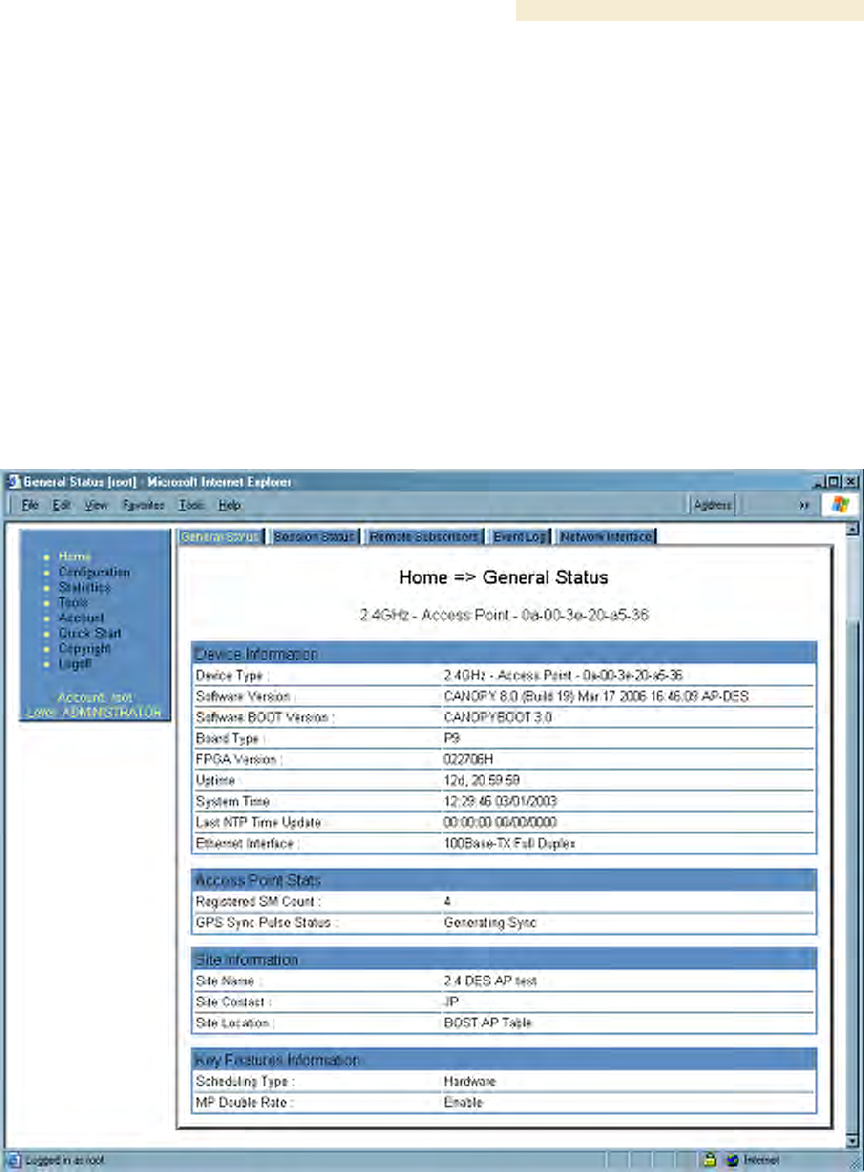
Release 8 Installation and Configuration Guide
Issue 2, December 2006 Draft 2 for Regulatory Review 201
◦ Board Type
◦ FPGA Version
3. Systematically ensure that you can retrieve this data (from a database, for
example) when you later prepare to deploy the SM to subscriber premises.
4. Return you to the Remote Subscribers tab of the AP.
5. Click the link of the next SM that you wish to test.
6. Repeat the test procedure from that point. When you have tested all of the SMs
that you intend to test, return your browser to the General Status tab of the AP.
=========================== end of procedure ===========================
16.3.8 General Status Tab of the AP
An example of an AP General Status tab is displayed in Figure 67.
Figure 67: General Status tab of AP, example
The General Status tab provides information on the operation of this AP. This is the tab
that opens by default when you access the GUI of the AP. The General Status tab
provides the following read-only fields.

Installation and Configuration Guide Release 8
202 Draft 2 for Regulatory Review Issue 2, December 2006
Device Type
This field indicates the type of the Canopy module. Values include the frequency band of
the AP, its module type, and its MAC address.
Software Version
This field indicates the Canopy system release, the time and date of the release, and
whether communications involving the module are secured by DES or AES encryption
(see Encrypting Canopy Radio Transmissions on Page 371). If you request technical
support, provide the information from this field.
Software BOOT Version
This field indicates the version of the CANOPYBOOT file. If you request technical
support, provide the information from this field.
Board Type
This field indicates the series of hardware. See Designations for Hardware in Radios on
Page 367.
FPGA Version
This field indicates the version of the field-programmable gate array (FPGA) on the
module. When you request technical support, provide the information from this field.
Uptime
This field indicates how long the module has operated since power was applied.
System Time
This field provides the current time. If the AP is connected to a CMM, then this field
provides GMT (Greenwich Mean Time). Any SM that registers to the AP inherits the
system time.
Last NTP Time Update
This field displays when the AP last used time sent from an NTP server. If the AP has not
been configured in the Time tab of the Configuration page to request time from an NTP
server, then this field is populated by 00:00:00 00/00/00.
Ethernet Interface
This field indicates the speed and duplex state of the Ethernet interface to the AP.
Registered SM Count
This field indicates how many SMs are registered to the AP.
GPS Sync Pulse Status
This field indicates the status of synchronization as follows:
◦ Generating sync indicates that the module is set to generate the sync pulse.
◦ Receiving Sync indicates that the module is set to receive a sync pulse from an
outside source and is receiving the pulse.
◦ ERROR: No Sync Pulse indicates that the module is set to receive a sync pulse
from an outside source and is not receiving the pulse.

Release 8 Installation and Configuration Guide
Issue 2, December 2006 Draft 2 for Regulatory Review 203
NOTE:
When this message is displayed, the AP transmitter is turned
off to avoid self-interference within the Canopy system.
Site Name
This field indicates the name of the physical module. You can assign or change this
name in the SNMP tab of the AP Configuration page. This information is also set into the
sysName SNMP MIB-II object and can be polled by an SNMP management server.
Site Contact
This field indicates contact information for the physical module. You can provide or
change this information in the SNMP tab of the AP Configuration page. This information
is also set into the sysName SNMP MIB-II object and can be polled by an SNMP
management server.
Site Location
This field indicates site information for the physical module. You can provide or change
this information in the SNMP tab of the AP Configuration page.
Scheduling Type
This field indicates the type of frame scheduler that is active in the AP.
MP Double Rate
This field indicates whether 2X modulation rate is enabled for the sector.
16.3.9 Concluding the Test of Point-to-Multipoint Links
To conclude the test, perform the following steps.
Procedure 11: Verifying and recording information from the AP
1. Confirm that the GPS Sync Pulse Status field indicates Generating Sync.
NOTE: This indication confirms that the AP is properly functional.
2. While your browser is directed to this General Status tab, note (or print) the
values of the following fields:
◦ Device type
◦ Software Version
◦ Software BOOT Version
◦ Board Type
◦ FPGA Version
3. Systematically ensure that you can retrieve this data when you prepare to deploy
the AP.
=========================== end of procedure ======================
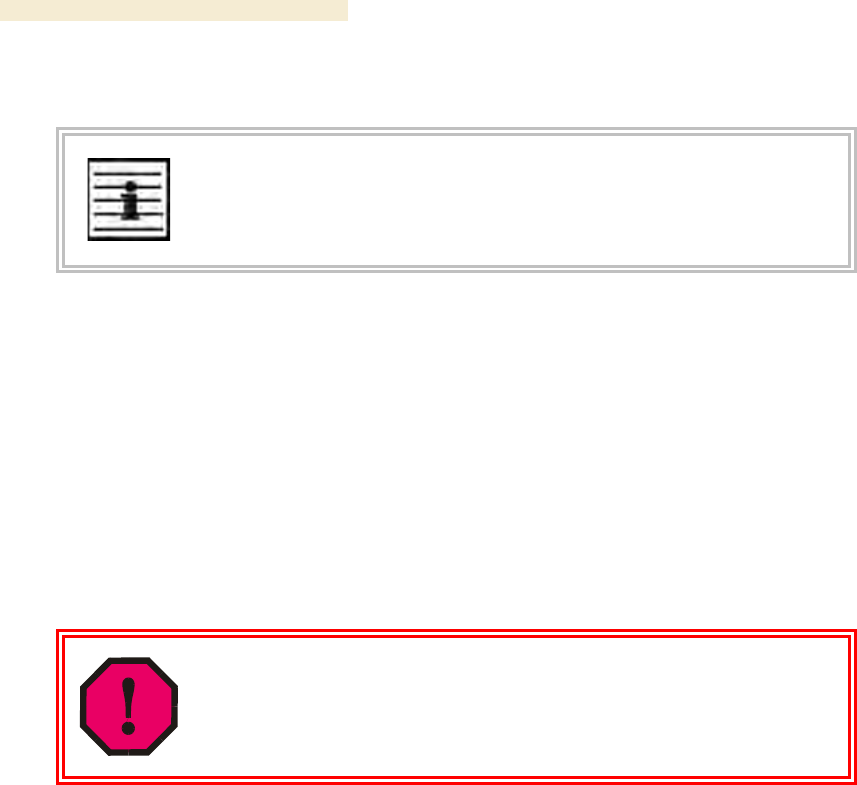
Installation and Configuration Guide Release 8
204 Draft 2 for Regulatory Review Issue 2, December 2006
16.4 CONFIGURING A POINT-TO-POINT LINK FOR TEST
NOTE:
This section supports the Canopy 10- and 20-Mbps Backhaul Modules. To find
setup and configuration guides that support the OFDM Series Backhaul
Modules, refer to Products Not Covered by This User Guide on Page 34.
Perform the following steps to begin the test setup.
Procedure 12: Setting up the BH for Quick Start
1. In one hand, securely hold the top (larger shell) of the BH that you intend to
deploy as a timing master. With the other hand, depress the lever in the back of
the base cover (smaller shell). Remove the base cover.
2. Plug one end of a CAT 5 Ethernet cable into the timing master.
3. Plug the other end of the Ethernet cable into the jack in the pig tail that hangs
from the power supply.
4. Plug the other connector of the pig tail into the Ethernet jack of the computing
device.
WARNING!
From this point until you remove power from the BH, stay at least as far from the
BH as the minimum separation distance specified under Preventing
Overexposure to RF on Page 169.
5. Plug the power supply into an electrical outlet.
6. Power up the computing device.
7. Start the browser in the computing device.
=========================== end of procedure ===========================
The Canopy BH interface provides a series of web pages to configure and monitor the
unit. These screens are subject to change by subsequent software releases.
You can access the web-based interface through only a computing device that is either
directly connected or connected through a network to the BH. If the computing device is
not connected to a network when you are configuring the module in your test
environment, and if the computer has used a proxy server address and port to configure
a Canopy module, then you may need to first disable the proxy setting in the computer.
To toggle the computer to not use the proxy setting, perform Procedure 6 on Page 185.
In the address bar of your browser, enter the IP address of the BHM (default is
169.254.1.1). The BHM responds by opening the General Status tab of its Home page.
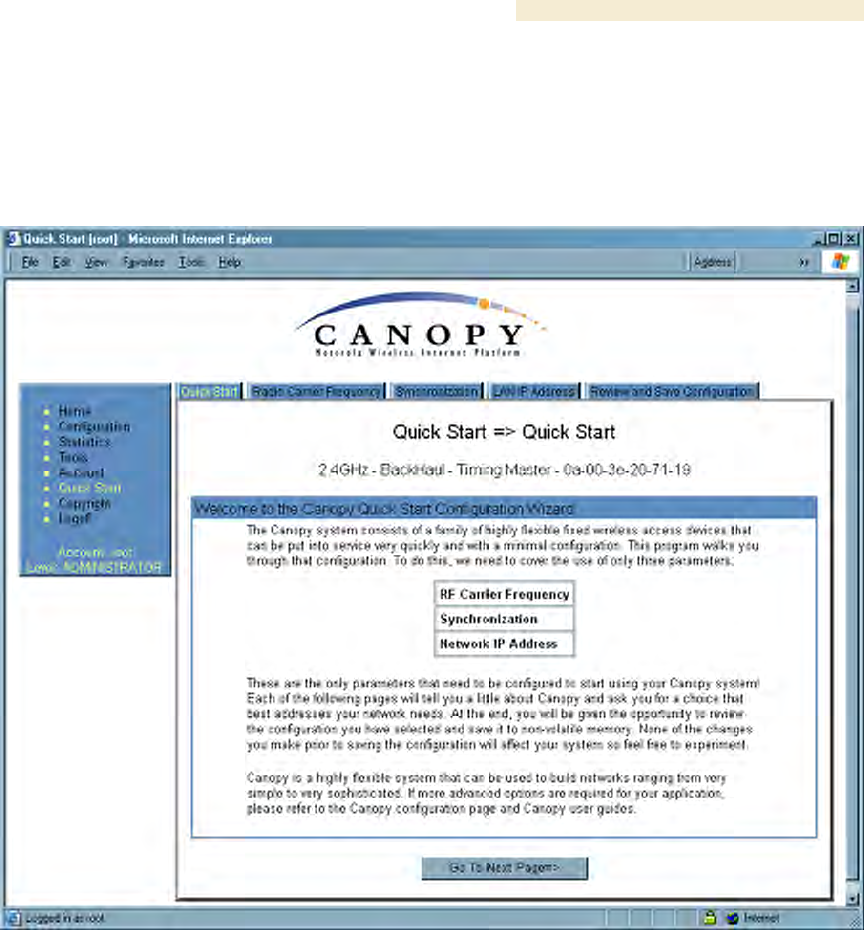
Release 8 Installation and Configuration Guide
Issue 2, December 2006 Draft 2 for Regulatory Review 205
16.4.1 Quick Start Page of the BHM
To proceed with the test setup, click the Quick Start button on the left side of the
General Status tab. The BHM responds by opening the Quick Start tab of the Quick Start
page. An example of this tab is displayed in Figure 68.
Figure 68: Quick Start tab of BHM, example
Quick Start is a wizard that helps you to perform a basic configuration that places a BHM
into service. Only the following variables must be configured:
◦ RF Carrier Frequency
◦ Synchronization
◦ Network IP Address
In each page under Quick Start, you can
◦ specify the settings to satisfy the requirements of the network.
◦ review the configuration selected.
◦ save the configuration to non-volatile memory.

Installation and Configuration Guide Release 8
206 Draft 2 for Regulatory Review Issue 2, December 2006
Proceed with the test setup as follows.
Procedure 13: Using Quick Start to configure the BHs for test
1. At the bottom of the Quick Start tab, click the Go To Next Page => button.
RESULT: The BHM responds by opening the RF Carrier Frequency tab.
2. From the pull-down menu in the lower left corner of this page, select a frequency
for the test.
3. Click the Go To Next Page => button.
RESULT: The BHM responds by opening the Synchronization tab.
4. At the bottom of this page, select Generate Sync Signal.
5. Click the Go To Next Page => button.
RESULT: The BHM responds by opening the LAN IP Address tab.
6. At the bottom of this tab, either
◦ specify an IP Address, Subnet Mask, and Gateway IP Address for
management of the BHM and leave the DHCP State set to Disabled.
◦ set the DHCP State to Enabled to have the IP address, subnet mask, and
gateway IP address automatically configured by a domain name server
(DNS).
7. Click the Go To Next Page => button.
RESULT: The BHM responds by opening the Review and Save Configuration
tab.
8. Ensure that the initial parameters for the BHM are set as you intended.
9. Click the Save Changes button.
10. On the left side of the tab, click the Configuration button.
RESULT: The BH responds by opening the General tab of its Configuration
page.
11. In the Timing Mode parameter, select Timing Master.
12. Click the Save Changes button.
13. Click the Reboot button.
RESULT: The BHM responds with the message Reboot Has Been Initiated….
This BH is now forced to provide sync for the link and has a distinct set of web
interface pages, tabs, and parameters for the role of BHM.
14. Wait until the indicator LEDs are not red.
15. Trigger your browser to refresh the page until the BHM redisplays the General
Status tab of its Home page.
16. Repeat these steps to configure the other BH in the pair to be a BHS, selecting
Timing Slave in Step 11.
=========================== end of procedure ===========================
Canopy encourages you to experiment with the interface. Unless you save a
configuration and reboot the BHM after you save the configuration, none of the changes
are effected.
16.4.2 Time Tab of the BHM
To proceed with the test setup, in the BHM, click the Configuration button on the left
side of the General Status tab. The BHM responds by opening its Configuration page to
the General tab. Click the Time tab. An example of this tab is displayed in Figure 69.
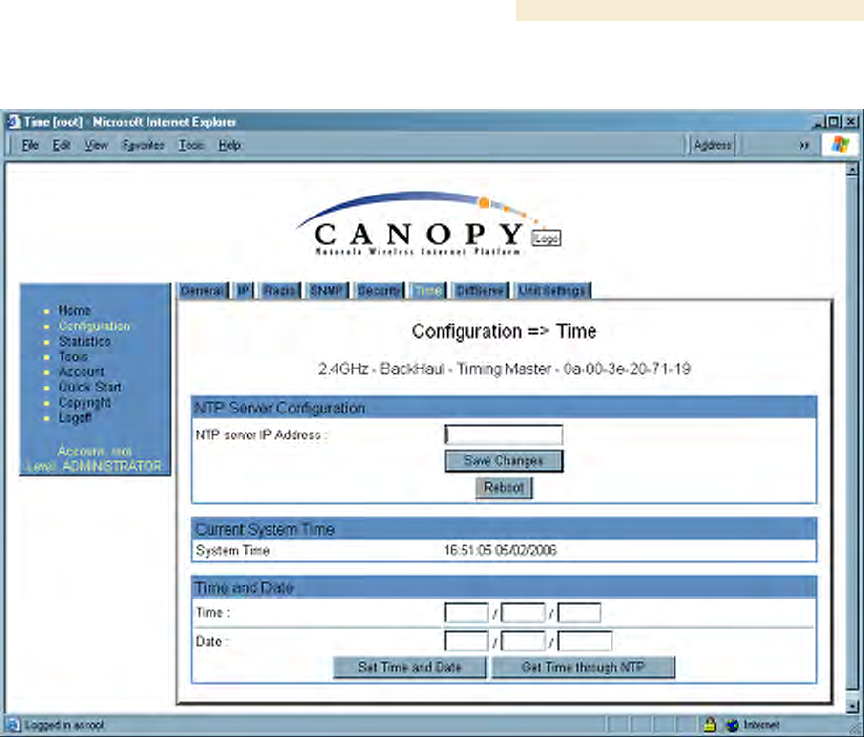
Release 8 Installation and Configuration Guide
Issue 2, December 2006 Draft 2 for Regulatory Review 207
Figure 69: Time tab of BHM, example
To have each log in the BHM correlated to a meaningful time and date, either a reliable
network element must pass time and date to the BHM or you must set the time and date
whenever a power cycle of the BHM has occurred. A network element passes time and
date in any of the following scenarios:
◦ A connected CMM2 passes time and date (GPS time and date, if received).
◦ A connected CMMmicro passes the time and date (GPS time and date, if
received), but only if the CMMmicro is operating on CMMmicro Release 2.1 or
later release. (These releases include an NTP server functionality.)
◦ A separate NTP server is addressable from the BHM.
If the BHM should derive time and date from either a CMMmicro or a separate NTP
server, enter the IP address of the CMMmicro or NTP server on this tab. To force the
BHM to derive time and date before the first (or next) 15-minute interval query of the NTP
server, click Get Time through NTP.
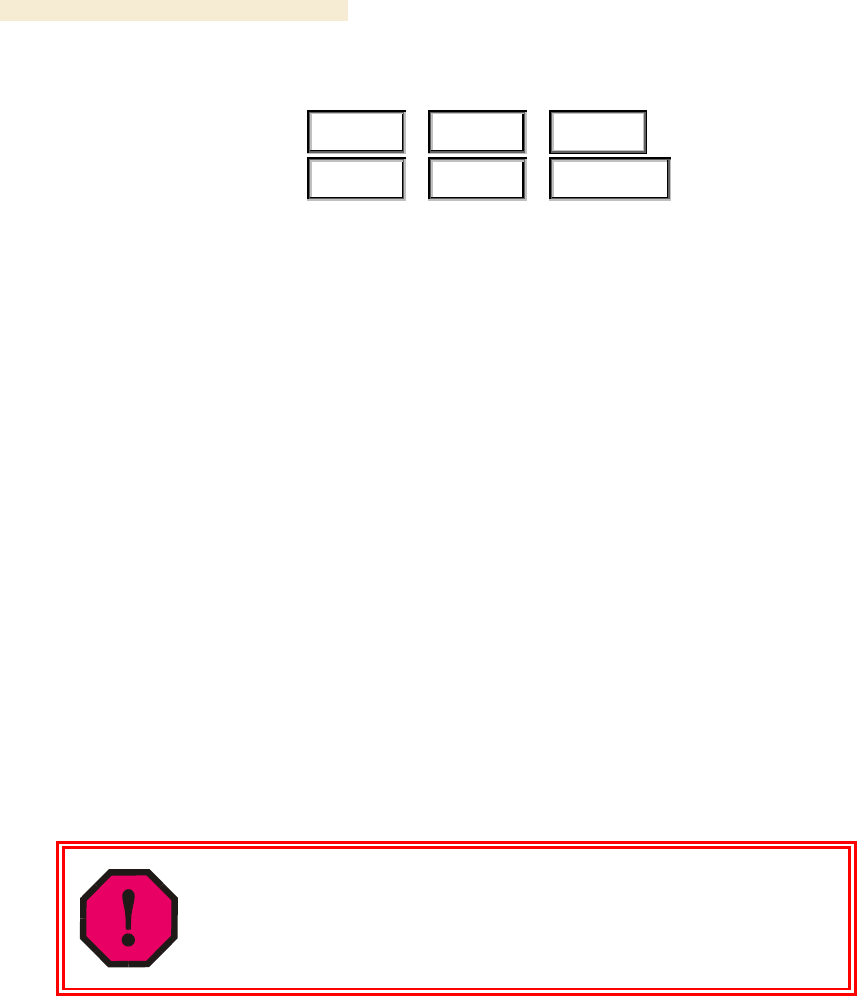
Installation and Configuration Guide Release 8
208 Draft 2 for Regulatory Review Issue 2, December 2006
If you enter a time and date, the format for entry is
Time :
hh
/
mm
/
ss
Date :
MM
/
dd
/
yyyy
where
hh
represents the two-digit hour in the range 00 to 24
mm
represents the two-digit minute
ss
represents the two-digit second
MM
represents the two-digit month
dd
represents the two-digit day
yyyy
represents the four-digit year
Proceed with the test setup as follows.
Procedure 14: Setting up the BHS for test
1. Enter the appropriate information in the format shown above.
2. Click the Set Time and Date button.
NOTE: The time displayed at the top of this page is static unless your browser is
set to automatically refresh.
3. In one hand, securely hold the top (larger shell) of the BH that you intend to
deploy as a timing slave. With the other hand, depress the lever in the back of
the base cover (smaller shell). Remove the base cover.
4. Plug one end of a CAT 5 Ethernet cable into the BHS.
5. Plug the other end of the Ethernet cable into the jack in the pig tail that hangs
from the power supply.
6. Roughly aim the BHS toward the BHM.
WARNING!
From this point until you remove power from the BHS, stay at least as far from
the BHS as the minimum separation distance specified under Preventing
Overexposure to RF on Page 169.
7. Plug the power supply into an electrical outlet.
8. Back at the computing device, on the left side of the BHM Time tab, click the
Home button. When the Home page opens to the General Status tab, click the
Remote Subscribers tab.
RESULT: The BHM opens the Remote Subscribers tab. An example of this tab is
shown in Figure 70.
=========================== end of procedure ======================
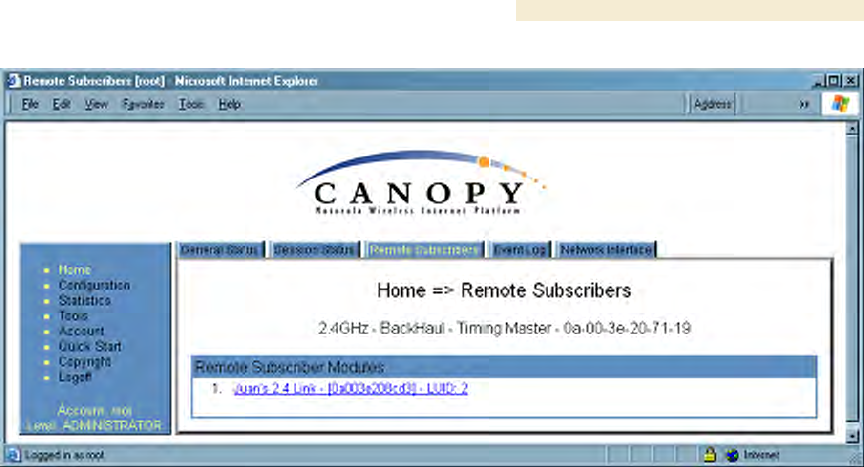
Release 8 Installation and Configuration Guide
Issue 2, December 2006 Draft 2 for Regulatory Review 209
Figure 70: Remote Subscribers tab of BHM, example
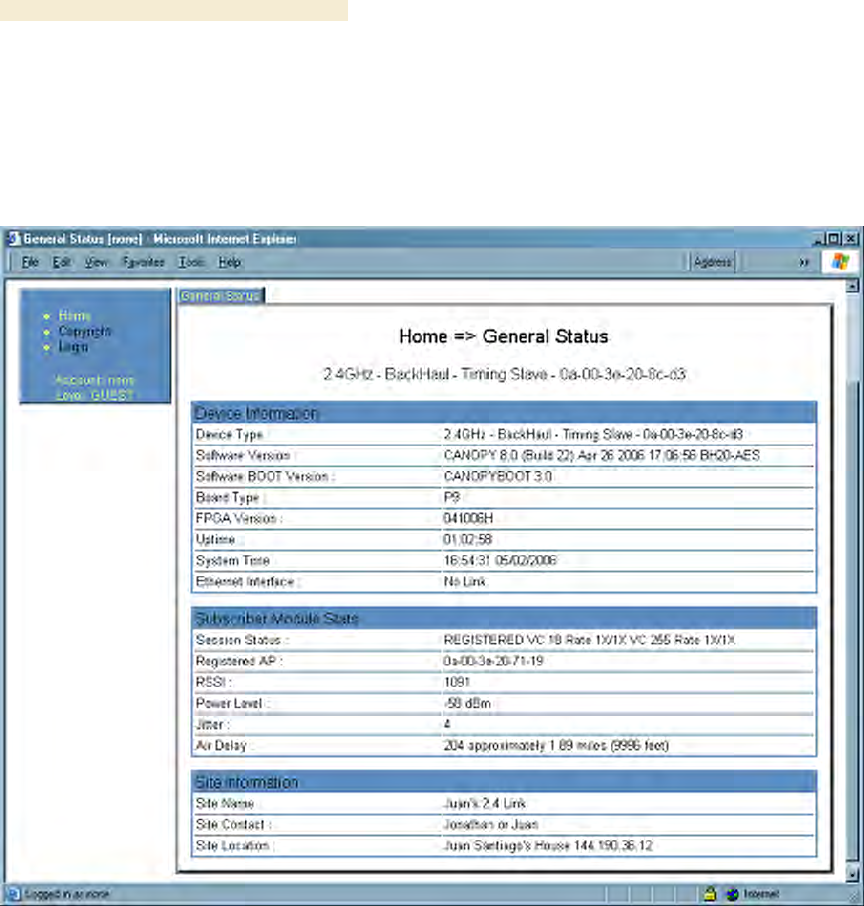
Installation and Configuration Guide Release 8
210 Draft 2 for Regulatory Review Issue 2, December 2006
16.4.3 Beginning the Test of Point-to-Point Links
To begin the test of your BH link, in the Remote Subscribers tab of the BHM, click the link
to the BHS. The BHS GUI opens to the General Status tab of its Home page.
An example of the BHS General Status tab is displayed in Figure 71.
Figure 71: General Status tab of BHS, example
The General Status tab provides information on the operation of this BHS. This is the tab
that opens by default when you access the GUI of the BHS. The General Status tab
provides the following read-only fields.
Device Type
This field indicates the type of the Canopy module. Values include the frequency band of
the BHS, its module type, and its MAC address.
Software Version
This field indicates the Canopy system release, the time and date of the release, the
modulation rate, and whether communications involving the module are secured by DES
or AES encryption (see Encrypting Canopy Radio Transmissions on Page 371). If you
request technical support, provide the information from this field.

Release 8 Installation and Configuration Guide
Issue 2, December 2006 Draft 2 for Regulatory Review 211
Software BOOT Version
This field indicates the version of the CANOPYBOOT file. If you request technical
support, provide the information from this field.
Board Type
This field indicates the series of hardware. See Designations for Hardware in Radios on
Page 367.
FPGA Version
This field indicates the version of the field-programmable gate array (FPGA) on the
module. When you request technical support, provide the information from this field.
Uptime
This field indicates how long the module has operated since power was applied.
System Time
This field provides the current time. When a BHS registers to a BHM, it inherits the
system time, which is displayed in this field as GMT (Greenwich Mean Time).
Ethernet Interface
This field indicates the speed and duplex state of the Ethernet interface to the BHS.
Session Status
This field displays the following information about the current session:
◦ Scanning indicates that this SM currently cycles through the RF frequencies that
are selected in the Radio tab of the Configuration page.
◦ Syncing indicates that this SM currently attempts to receive sync.
◦ Registering indicates that this SM has sent a registration request message to
the AP and has not yet received a response.
◦ Registered indicates that this SM is both
− registered to an AP.
− ready to transmit and receive data packets.
◦ Alignment indicates that this SM is in an aiming mode. See Table 44 on
Page 179.
Registered AP
This field displays the MAC address of the BHM to which this BHS is registered.
RSSI, Power Level, and Jitter
The General Status tab shows the received Power Level in dBm and Jitter. Proper
alignment maximizes Power Level and minimizes Jitter. As you refine alignment, you
should favor lower jitter over higher dBm. For example, if coarse alignment gives the BHS
a power level of −75 dBm and a jitter measurement of 5, and further refining
the alignment drops the power level to −78 dBm and the jitter to 2 or 3, use the refined
alignment, with the following caveats:
◦ When the receiving link is operating at 1X, the Jitter scale is 0 to 15 with desired
jitter between 0 and 4.
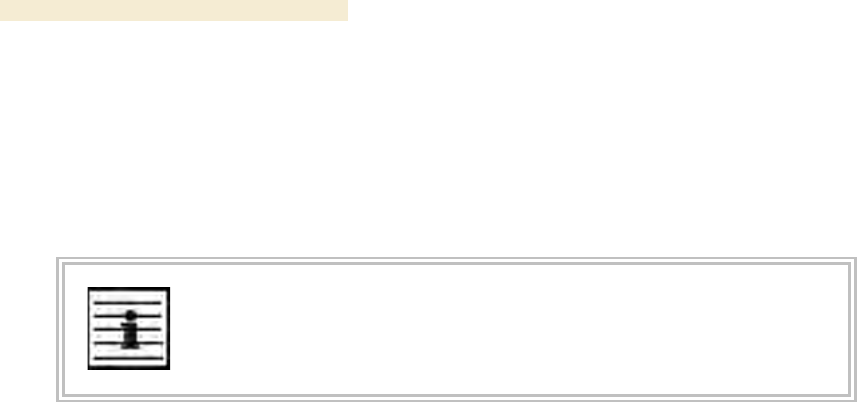
Installation and Configuration Guide Release 8
212 Draft 2 for Regulatory Review Issue 2, December 2006
◦ When the receiving link is operating at 2X, the Jitter scale is 0 to 15 with desired
jitter between 0 and 9.
For historical relevance, the General Status tab also shows the RSSI, the unitless
measure of power. Use Power Level and ignore RSSI. RSSI implies more accuracy and
precision than is inherent in its measurement.
NOTE:
Unless the page is set to auto-refresh, the values displayed are from the instant
the General Status tab was selected. To keep a current view of the values,
refresh the browser screen or set to auto-refresh.
Air Delay
This field displays the distance in feet between the BHS and the BHM. To derive the
distance in meters, multiply the value of this parameter by 0.3048. Distances reported as
less than 200 feet (61 meters) are unreliable.
Site Name
This field indicates the name of the physical module. You can assign or change this
name in the SNMP tab of the BHS Configuration page. This information is also set into
the sysName SNMP MIB-II object and can be polled by an SNMP management server.
Site Contact
This field indicates contact information for the physical module. You can provide or
change this information in the SNMP tab of the BHS Configuration page. This information
is also set into the sysName SNMP MIB-II object and can be polled by an SNMP
management server.
Site Location
This field indicates site information for the physical module. You can provide or change
this information in the SNMP tab of the BHS Configuration page.
16.4.4 Continuing the Test of Point-to-Point Links
To resume the test, perform the following steps.
Procedure 15: Verifying and recording information from the BHS
1. Verify that the Session Status field of the General Status tab in the BHS
indicates REGISTERED.
NOTE: This indication confirms that the BHS is properly functional.
2. While your browser is set to the General Status tab, note (or print) the values of
the following fields:
◦ Device type
◦ Software Version
◦ Software BOOT Version
◦ Board Type
◦ FPGA Version
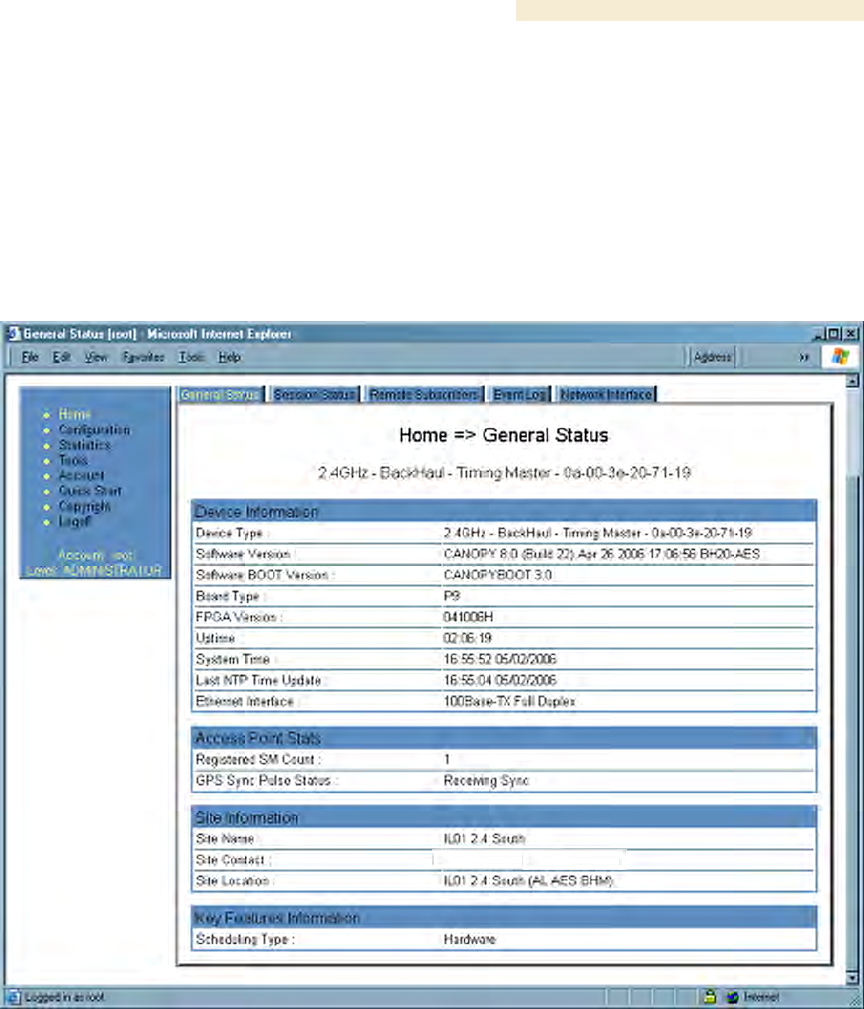
Release 8 Installation and Configuration Guide
Issue 2, December 2006 Draft 2 for Regulatory Review 213
3. Systematically ensure that you can retrieve this data when you prepare to deploy
the BHS.
4. Return your browser to the General Status tab of the BHM.
=========================== end of procedure ======================
16.4.5 General Status Tab of the BHM
An example of a BHM General Status tab is displayed in Figure 72.
Figure 72: General Status tab of BHM, example
The Status page provides information on the operation of the module. This is the default
web page for the module. The Status page provides the following fields.
Device Type
This field indicates the type of the Canopy module. Values include the frequency band of
the module, the module type, timing mode, and the MAC address of the module.
Software Version
This field indicates the software release that is operated on the module, the release date
and time of the software release, the modulation rate capability, and whether the module

Installation and Configuration Guide Release 8
214 Draft 2 for Regulatory Review Issue 2, December 2006
is secured by DES or AES encryption (see Encrypting Canopy Radio Transmissions on
Page 371). When you request technical support, provide the information from this field.
Software BOOT Version
This field indicates the version of the CANOPYBOOT file. If you request technical
support, provide the information from this field.
Board Type
This field indicates the series of hardware. See Designations for Hardware in Radios on
Page 367.
FPGA Version
This field indicates the version of the field-programmable gate array (FPGA) on the
module. When you request technical support, provide the information from this field.
Uptime
This field indicates how long the module has operated since power was applied.
System Time
This field provides the current time. If the BHM is connected to a CMM, then this field
provides GMT (Greenwich Mean Time). The BHS that registers to the BHM inherits the
system time.
Last NTP Time Update
If the Time & Date page of the module specifies that time should be received from an
NTP server, then this field indicates when the time was last updated by a Network Time
Protocol (NTP) server.
Ethernet Interface
This field indicates the speed and duplex state of the Ethernet interface to the module.
Registered SM Count
This field confirms that only one BHS is registered to the BHM.
GPS Sync Pulse Status
This field indicates the status of synchronization as follows:
◦ Generating sync indicates that the module is set to generate the sync pulse.
◦ Receiving Sync indicates that the module is set to receive a sync pulse from an
outside source and is receiving the pulse.
◦ ERROR: No Sync Pulse indicates that the module is set to receive a sync pulse
from an outside source and is not receiving the pulse.
NOTE:
When this message is displayed, the BHM transmitter is turned off to
avoid self-interference within the Canopy system.

Release 8 Installation and Configuration Guide
Issue 2, December 2006 Draft 2 for Regulatory Review 215
Site Name
This field indicates the name of the physical module. You can assign or change this
name in the SNMP tab of the BHM Configuration page. This information is also set into
the sysName SNMP MIB-II object and can be polled by an SNMP management server.
Site Contact
This field indicates contact information for the physical module. You can provide or
change this information in the SNMP tab of the BHM Configuration page. This information
is also set into the sysName SNMP MIB-II object and can be polled by an SNMP
management server.
Site Location
This field indicates site information for the physical module. You can provide or change
this information in the SNMP tab of the BHM Configuration page.
Scheduling Type
This field indicates the type of frame scheduler that is active in the BHM.
16.4.6 Concluding the Test of Point-to-Point Links
To conclude the test, perform the following steps.
Procedure 16: Verifying and recording information from the BHM
1. Confirm that the GPS Sync Pulse Status field indicates Generating Sync.
NOTE: This indication confirms that the BHM is properly functional.
2. While your browser is set to this BHM Status page, note (or print) the values of
the following fields:
◦ Device type
◦ Software Version
◦ Software BOOT Version
◦ Board Type
◦ FPGA Version
3. Systematically ensure that you can retrieve this data when you prepare to deploy
the BHM.
=========================== end of procedure ===========================
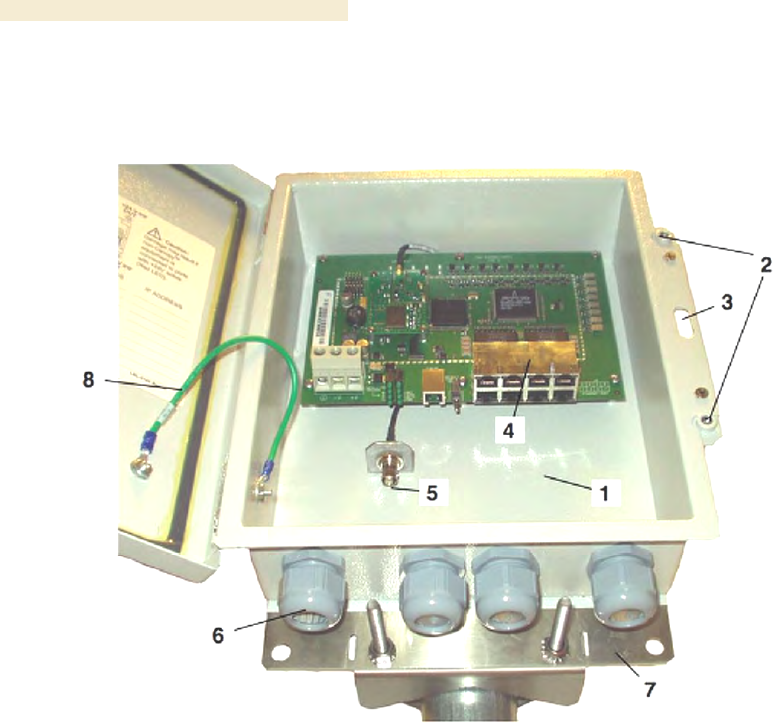
Installation and Configuration Guide Release 8
216 Draft 2 for Regulatory Review Issue 2, December 2006
16.4.7 Setting up a CMMmicro
The layout of the CMMmicro is as shown in Figure 73.
1 Weatherized enclosure
2 Thumb-screw/slot-screwdriver door fasteners
3 Punch-out for padlock
4 Ethernet switch and power module
5 Female BNC connector
6 Water-tight bulkhead connectors
7 Flange for attachment (stainless steel so it grounds to tower or building) using
U bolts (provided) or other hardware such as screws or lag bolts or attachment
straps (not provided).
8 Ground strap to ground door to enclosure
Figure 73: CMMmicro layout